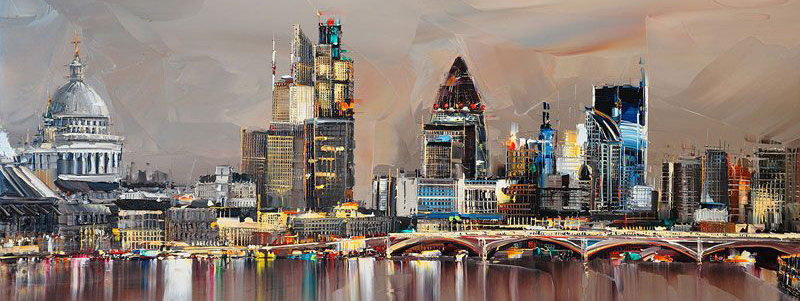Fleet Street - Blackfriars - Temple - Inns of Court - St. Paul's Cathedral and surrounding area - North of Ludgate Hill - The Guildhalls and surrounding area

Until the Middle Ages, the City used to make up most of London. In the Eighteenth and Nineteenth Century there were many more people living there than there are today, as it now essentially serves as the headquarters of many offices and legal practices. Today there are eight thousand residents, however over three hundred thousand people commute there for work each day. In order to invert this tendency in what is considered the true historical centre of the metropolis, attempts are being made to encourage the residential use of the area, and to this end, hotels have been opened, as well as variety shops. Unfortunately, also a number of steel and glass skyscrapers have also been built, which look out of place beside the ancient Georgian and Victorian buildings of the neighbourhood. Virginia Woolf once said that these modern constructions have an air of impermanence about them and look like they could easily crumble from one minute to the next. Whatever the case, they most certainly appear as intruders.
The old square mile is packed full of buildings of significant historical, artistic, and architectural importance, all densely concentrated in one small area. Many of the religious buildings date back to Wren and the Eighteenth century. Yet with time, the white stone walls have been dirtied, and the plaster and the statues which stand in the corners have gathered layers of soot.

During the Middle Ages the neighbourhood was a theatre for street shows. There would be fire breathers, bears, trained elephants, and the so called "freak shows".
As well as the old churches and the ancient Roman ruins, the City is full of other delightful hidden gardens where one can stop for a while. For a stroll in the neighbourhood, one can take the famous Monument as a starting point and head towards Liverpool Street Station. Whilst heading up along Lombard Street, Bishopsgate, and Finsbury Circus, one walks past a great many churches, pubs, passages, gardens, and monuments.
Currently Fleet Street is much too narrow for the amount of traffic that it is supposed to provide for.
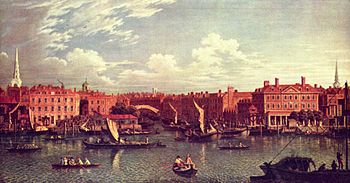 There was a time, however, when this route was taken up by the homonymous river, which was later covered up. Its bed was big enough to keep a boat afloat, and this seems to be the reason of its original Saxon name.
There was a time, however, when this route was taken up by the homonymous river, which was later covered up. Its bed was big enough to keep a boat afloat, and this seems to be the reason of its original Saxon name.The river originated from two sources in Hampstead Heath and would descend along the Vale of Heath, below New Bridge Street. Then it would become a series of ponds, named Hampstead Ponds and Highgate Ponds, which served as water reservoirs. The segment on the side of Parliament Hill flowed underground, and likewise the section just after Camden Town, where the river would reach its greatest width. It would then flow into the Thames near the Blackfriars bridge and its outlet can still be seen today. The intersection between the Fleet River and the Thames was one of the first places where people started building in London. Throughout the centuries, the Fleet has not only provided water for the inhabitants, but it has also been used as a communicating passage, and as a way to power mills. Unfortunately its bed has also been used for disposing with waste, to the point of transforming it into an open-air sewer. It was the so-called "Great Stink" that convinced administrators to close it off and link it to the sewage system. And so it was that Fleet Street was born, a street connecting the City and Westminster.

For four centuries, the street, which goes from Temple Bar to Ludgate Circus and connects the City to Westminster, was the headquarters of the press. Amongst them, at street number 128 was the Daily Express and at 135 was the Daily Telegraph. Even today, the street is associated with the press, even though the newspapers all have their headquarters at the Docklands and only lawyers and courts still reside here.
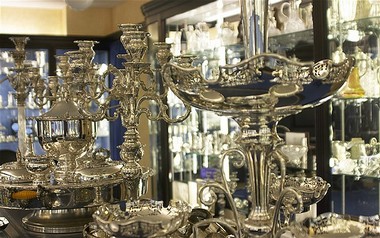 Fleet Street is a historical street, densely packed into a small space, and also its pubs are rich with history - El Vino in Hare Place is perhaps the most renowned - lined with coffee shops, restaurants, and traditional boutiques. And just north of Fleet Street, in Chancery Lane, is the Silver Vaults shop. The ideal moment to come here is towards the end of the week, so that one can peacefully walk along the street without too much traffic.
Fleet Street is a historical street, densely packed into a small space, and also its pubs are rich with history - El Vino in Hare Place is perhaps the most renowned - lined with coffee shops, restaurants, and traditional boutiques. And just north of Fleet Street, in Chancery Lane, is the Silver Vaults shop. The ideal moment to come here is towards the end of the week, so that one can peacefully walk along the street without too much traffic. In Fleet Place there is also an unusual building from 1993 by Ellis O'Connell, called the Zunì-Ziamr, which represents a series arrows, their stems intertwining.
"When a man is tired of London, he is tired of life" Dr. Johnson used to say. And those tired of the surface of London, can visit the underground sewers, which are more beautiful than the Parisian ones, yet less accessible, although the current Mayor wishes to open them permanently to visitors. For now the problem remains that the flushers - the name given to the sewage maintenance workers - are less than fifty in number and do not have much time to dedicate to the public. All that one can do is make a phone call to the number found on the Internet and hope to be admitted to visit what is an absolutely spectacular piece of history of the city. The stone arches, bare bricks, old Nineteenth-Century staircases, the chambers with high vaulted ceilings, and the infinite corridors, truly show the genius of Bazalgette, the engineer who created this great project, developed over fifty thousand kilometres, which thousands of men worked for sixteen years to build, using somewhere around three hundred and twenty thousand bricks.
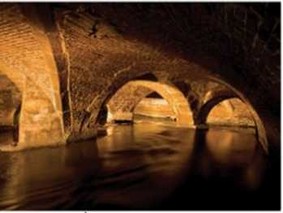 The tunnels are all connected to each other and have remained unchanged since 1850 until today, however the combined system of water drainage and sewers proves to be insufficient when it rains relentlessly, and especially when this coincides with high tides. It is not an easily solved problem, although presently some modifications are being made which will be ready within a few years.
The tunnels are all connected to each other and have remained unchanged since 1850 until today, however the combined system of water drainage and sewers proves to be insufficient when it rains relentlessly, and especially when this coincides with high tides. It is not an easily solved problem, although presently some modifications are being made which will be ready within a few years.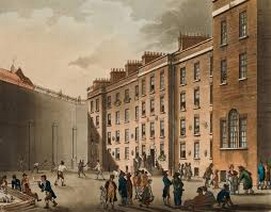 The prison was built around the year 1090, during the reign of William Rufus, on a cross street of Farringdon Street. The building stood on the bank of the river Fleet, and, in the Middle Ages, hosted mainly political prisoners. Later on, it was a home to the indebted and people committed by the Star Chamber. The edifice was destroyed twice, during the farmer's revolt in 1381 and during the Great Fire of 1666, yet it was rebuilt each time. In the Eighteenth Century it took in the bankrupt and their families, and prisoners whose cell overlooked the street would beg the passers-by in order to pay for their board and lodging, which had to be paid back. One also had to pay a tax to have one's chains removed, which were sometimes placed arbitrarily just to extort some extra money. Weddings were celebrated in the prison, known as Fleet Marriages, without licence or notice, often by ministers held in jail for their debts. Also the Elizabethan poet John Donne, dean of St Paul, was jailed here together with the priest who had married him, and here he stayed until he was able to prove that his marriage with Anne More was valid. The prison building was demolished in 1846.
The prison was built around the year 1090, during the reign of William Rufus, on a cross street of Farringdon Street. The building stood on the bank of the river Fleet, and, in the Middle Ages, hosted mainly political prisoners. Later on, it was a home to the indebted and people committed by the Star Chamber. The edifice was destroyed twice, during the farmer's revolt in 1381 and during the Great Fire of 1666, yet it was rebuilt each time. In the Eighteenth Century it took in the bankrupt and their families, and prisoners whose cell overlooked the street would beg the passers-by in order to pay for their board and lodging, which had to be paid back. One also had to pay a tax to have one's chains removed, which were sometimes placed arbitrarily just to extort some extra money. Weddings were celebrated in the prison, known as Fleet Marriages, without licence or notice, often by ministers held in jail for their debts. Also the Elizabethan poet John Donne, dean of St Paul, was jailed here together with the priest who had married him, and here he stayed until he was able to prove that his marriage with Anne More was valid. The prison building was demolished in 1846.C. HOARE & CO.
37 FLEET STREET
UNDERGROUND: BLACKFRIARS. CHANCERY
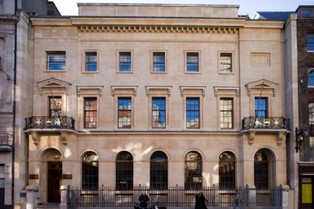 The bank C. Hoare & Co. was the oldest in Great Britain. It was founded in 1672 by Richard Hoare and belonged to the family for almost four hundred years.
The bank C. Hoare & Co. was the oldest in Great Britain. It was founded in 1672 by Richard Hoare and belonged to the family for almost four hundred years.The first location was near the Golden Bottle sign in Cheapside, then later it was transferred to Fleet Street a few years later. It is the only private bank to have survived for so many years and it was one of the first institutions (in this, preceding even the Bank of England) to pay its employees their pensions. At the beginning of the Twentieth Century this was unheard of, to the point that most people would simply work all their lives. The oldest were active until the age of eighty, in the hope of not falling ill, for this would mean that they would suddenly be lacking any means of survival.
Modernity, with its cold and shiny materials, has never set foot in this hall, where everything is made of wood. Behind glass booths, the staff look unhurried, there are errand runners in uniform braided porters with top hats. On the first floor there is a museum.
The building has maintained the name of the newspaper which had headquarters here since 1931 and during the years of greatest success in sales, this was also thanks to news about gossip and the scandals of famous characters. 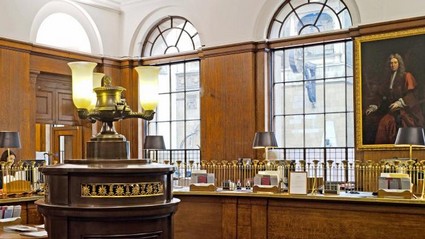 It is a building with black glass and metal, in Art Deco style. In a recess in the facade it bears two vast window panes with Express in red vertical writing, with the letters made of iron. The insides have become a wonderful Art Deco area, belonging to Goldman Sachs. People who work in the art world come here often. Those who are not a part of it need to contact one of the associations which have right of access, like for example the Nineteenth Century Fine Art Society based in 148, New Bond Street. Through them, one can freely witness one of the most beautiful exhibitions of sculptures, ceramics, and modern design. It really is worth the effort!
It is a building with black glass and metal, in Art Deco style. In a recess in the facade it bears two vast window panes with Express in red vertical writing, with the letters made of iron. The insides have become a wonderful Art Deco area, belonging to Goldman Sachs. People who work in the art world come here often. Those who are not a part of it need to contact one of the associations which have right of access, like for example the Nineteenth Century Fine Art Society based in 148, New Bond Street. Through them, one can freely witness one of the most beautiful exhibitions of sculptures, ceramics, and modern design. It really is worth the effort!
 It is a building with black glass and metal, in Art Deco style. In a recess in the facade it bears two vast window panes with Express in red vertical writing, with the letters made of iron. The insides have become a wonderful Art Deco area, belonging to Goldman Sachs. People who work in the art world come here often. Those who are not a part of it need to contact one of the associations which have right of access, like for example the Nineteenth Century Fine Art Society based in 148, New Bond Street. Through them, one can freely witness one of the most beautiful exhibitions of sculptures, ceramics, and modern design. It really is worth the effort!
It is a building with black glass and metal, in Art Deco style. In a recess in the facade it bears two vast window panes with Express in red vertical writing, with the letters made of iron. The insides have become a wonderful Art Deco area, belonging to Goldman Sachs. People who work in the art world come here often. Those who are not a part of it need to contact one of the associations which have right of access, like for example the Nineteenth Century Fine Art Society based in 148, New Bond Street. Through them, one can freely witness one of the most beautiful exhibitions of sculptures, ceramics, and modern design. It really is worth the effort!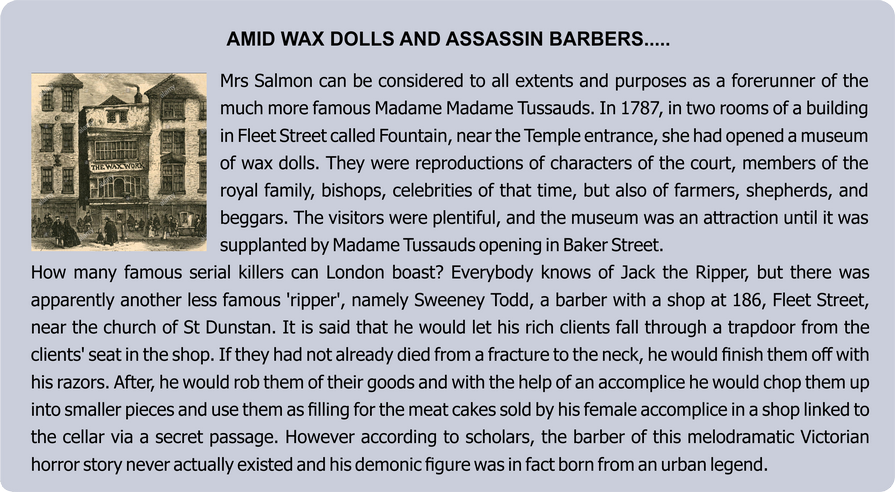
ST DUNSTAN'S CHURCH- IN-THE-WEST
184 FLEET STREET
UNDERGROUND: BLACKFRIARS
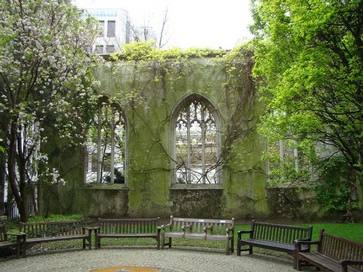
Before the Great Fire of London, the City sported a hundred churches, more than elsewhere, and many monasteries. Amongst these was the Whitefriars monastery (literally belonging to the white friars, as the Carmelites were called). Its territory included cloisters, churches, and cemeteries, and went from Fleet Street to the Thames. Nowadays all that is left is a crypt dating back to the 14th Century, located between Bouverie Street and Whitefriars Street, at the bottom of Magpie Alley. On the street tiles of this street, the story of the Fleet Street publishing houses is told.
The old medieval building of St Dunstan's, built in the year 1000, was demolished because it blocked out Fleet Street. Near the Breams Buildings a fragment of the old cemetery remains.
St Dunstan, whom the church is dedicated to, lived between the year 909 and 988 and was a monk and the archbishop of Canterbury, under various kings. According to legend, he was particularly skilled at negotiating with the Devil.
Dunstan is the patron saint of clockmakers, blacksmiths, and weaponsmiths, and is celebrated on May 19th. Once a year the Company of cordwainers - the old English name for shoemakers - hold a religious meeting in this church.
It was here that between 1624 and 1631 John Donne was vicar (vicarages did not pay feudal tithes) and Samuel Pepys would come here for the religious service, but was easily distracted. William Tyndale, translator of the Bible, would speak at conferences held here.
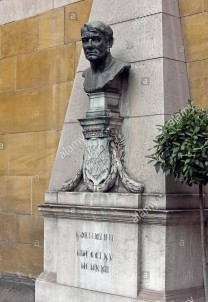 The current building dates back to 1833 and, like all English churches, has many monuments commemorating the dead, plaques, urns, and busts from passed ages, of which one can deduce the citizens characteristics and the history of their families. The plaque in memory of the banker James Chandler, spokesman for the City sovereign, tells of his virtues, amongst which are his generosity in life towards his relatives, to whom he donated twenty thousand pounds. The plaque dedicated to Alexander Leyson states that he was a famous swordsman. Near the church, where today one can find a passage which borrows the same name, was Clifford's Inn, the first Inn of Chancery, which was the Court of Justice of the lord chancellor, founded within the city.
The current building dates back to 1833 and, like all English churches, has many monuments commemorating the dead, plaques, urns, and busts from passed ages, of which one can deduce the citizens characteristics and the history of their families. The plaque in memory of the banker James Chandler, spokesman for the City sovereign, tells of his virtues, amongst which are his generosity in life towards his relatives, to whom he donated twenty thousand pounds. The plaque dedicated to Alexander Leyson states that he was a famous swordsman. Near the church, where today one can find a passage which borrows the same name, was Clifford's Inn, the first Inn of Chancery, which was the Court of Justice of the lord chancellor, founded within the city. The clock on the church facade dates back to 1671 and was the first to have minute hands. The two statues of muscular giants, who mark each hour by beating the bells with their clubs and move their adjustable heads each quarter of an hour are perhaps a representation of Gog and Magog. Above the vicarage school door there is a statue of queen Elkizabeth I, fulfilled in 1586 by Thomas Harris. It is the most ancient statue placed outside, together with those under the colonnade, to represent King Lud and his two sons.
KING LUD AND SONS
ST DUNSTAN'S CHURCHYARD
UNDERGROUND: TEMPLE, BLACKFRIARS
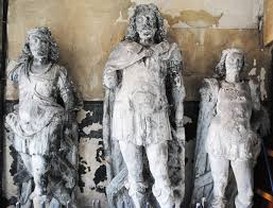 Originally these statues of King Lud and his sons adorned Lud Gate, one of the entries to the City, near the river Fleet, where today Ludgate Circus is located. In 1833, when Ludgate was demolished, the statues were removed and after St Dunstan's church had been rebuilt, they were placed next to the external wall under the small porch.
Originally these statues of King Lud and his sons adorned Lud Gate, one of the entries to the City, near the river Fleet, where today Ludgate Circus is located. In 1833, when Ludgate was demolished, the statues were removed and after St Dunstan's church had been rebuilt, they were placed next to the external wall under the small porch.The large rock sitting on the corner of Pilgrim Street is a piece of the old door and was perhaps placed here to avoid the wheels of carts or-wagons from hitting the edge of the house.

DR. JOHNSON'S HOUSE
17 GOUGH SQUARE
UNDERGROUND: BLACKFRIARS
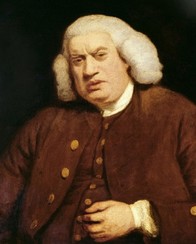 This house in dark bricks is a real jewel and one of the few Eighteenth Century to have survived in London. In his attic, Dr. Johnson, helped by six amanuenses, compiled the first complete English Dictionary. For nine years, from 1748 to 1757, scribes wrote under dictation standing in front of a long table. Until then, to explain a word, synonyms were used. Johnson was the first to explain terms by reconstructing the etymology and defining them, although at times his definitions were not neutral, as they are now, but humorous and sarcastic. His Dictionary also contains - citations which have become habitual. In 1752, his beloved wife, who was twenty years older than him, died here. In 1758 he ended up in prison for debts, in spite of his merits. Once he had finished the efforts placed in compiling his dictionary and been released from jail, Dr. Johnson immediately set off on another adventure, that of founding a newspaper, Tbe Rambler, which he directed and wrote for. The English word ram- bler has several meanings. It can be said of hikers, roses that climb walls, but also of aimless wandering and digressing, speaking incoherently going from one subject to the next without any clear purpose or direction, and this is the meaning of the title.
This house in dark bricks is a real jewel and one of the few Eighteenth Century to have survived in London. In his attic, Dr. Johnson, helped by six amanuenses, compiled the first complete English Dictionary. For nine years, from 1748 to 1757, scribes wrote under dictation standing in front of a long table. Until then, to explain a word, synonyms were used. Johnson was the first to explain terms by reconstructing the etymology and defining them, although at times his definitions were not neutral, as they are now, but humorous and sarcastic. His Dictionary also contains - citations which have become habitual. In 1752, his beloved wife, who was twenty years older than him, died here. In 1758 he ended up in prison for debts, in spite of his merits. Once he had finished the efforts placed in compiling his dictionary and been released from jail, Dr. Johnson immediately set off on another adventure, that of founding a newspaper, Tbe Rambler, which he directed and wrote for. The English word ram- bler has several meanings. It can be said of hikers, roses that climb walls, but also of aimless wandering and digressing, speaking incoherently going from one subject to the next without any clear purpose or direction, and this is the meaning of the title.
Up until 1911 the house remained abandoned, after also having been used as an undistinguished hotel. Later it was bought by Cecil Harmsworth who transformed it into a museum. The rooms are dressed with panels, the wooden stairs are shiny and well-restored, the simple furniture of the period give the building the atmosphere of a private house. From the windows one can view the letters, press, portraits, and books, and in the Dictionary Room of the attic there are the first two editions of the Dictionary.
Amongst the items of furniture there is a chair which did not originally belong to the house, but to a small nearby tavern where Dr. Johnson would go. The writer would sit down to a good tankard of beer and recover from the day's struggles. The large cast iron feline represents Hodge, Dr. Johnson's beloved cat, who according to him resembled a four-legged owl, whom he would ask opinions of, regarding the controversial passages of his Dictionary.
ST BRIDE'S CHURCH
ST BRIDE'S AVENUEUNDERGROUND: BLACKFRIARS
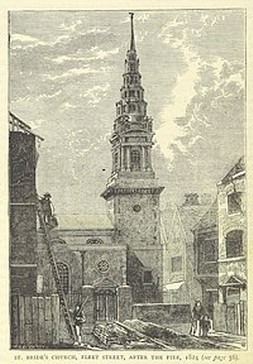 According to archaeologists, there was already a church in this area already one thousand five hundred years ago. For over five centuries this was the church of journalists and of those who worked in the media; today it is attended by agents and finance and trade workers.
According to archaeologists, there was already a church in this area already one thousand five hundred years ago. For over five centuries this was the church of journalists and of those who worked in the media; today it is attended by agents and finance and trade workers.It is the most ancient Christian church in English church and the present building, the seventh so far, was designed by Christopher Wren in 1672. It is dedicated to St. Brigid of Kildare in Ireland, and was perhaps founded by a community of Celtic monks. The first session of the Parliament, held by King John in 1210 took place here. There is also an altar commemorating the Pilgrim Fathers. During the Blitz, the Wren church was destroyed and the only part to survive was the beautiful Italian-style belfry, dating back to 1703, seventy five metres tall. Its reconstruction has been carried out closely following Wren's design.
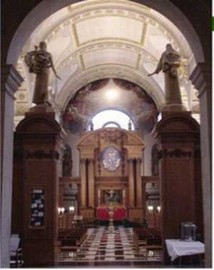 In Celtic mythology, Bride was the name of the pagan goddess of fire and was also called Bridget of Kildare. All that is known of her is who lived between the year 453 and 523 and who converted to the Christian religion at the age of six, inspired by the preachings of St Patrick and who, having become a nun, had founded a large monastery in her village as a base for the evangelization of the country. She is one of the patron saints of Ireland, alongside S. Patrick and St. Columba, and her figure is associated with justice and charity. Legends says that her father had decided to convert himself upon his death bed and had asked her to be baptized. Brigid then took some reeds and tied them to make a cross. Still today St. Brigid's Cross, made of sticks and straw, is placed under the roof of houses to protect them from adversity.
In Celtic mythology, Bride was the name of the pagan goddess of fire and was also called Bridget of Kildare. All that is known of her is who lived between the year 453 and 523 and who converted to the Christian religion at the age of six, inspired by the preachings of St Patrick and who, having become a nun, had founded a large monastery in her village as a base for the evangelization of the country. She is one of the patron saints of Ireland, alongside S. Patrick and St. Columba, and her figure is associated with justice and charity. Legends says that her father had decided to convert himself upon his death bed and had asked her to be baptized. Brigid then took some reeds and tied them to make a cross. Still today St. Brigid's Cross, made of sticks and straw, is placed under the roof of houses to protect them from adversity. MUSEUM AND ST BRIDE'S CRYPT
ST BRIDE'S AVENUE
UNDERGROUND: BLACKFRIARS
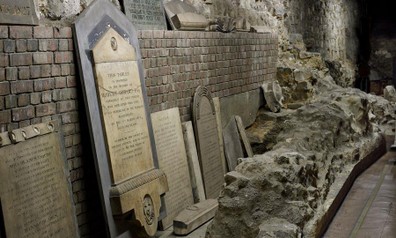 The holes made by the bombs of World War II brought to light many objects buried under the church and thousands of skeletons. It was then discovered that in the Middle Ages, there was a charnel house where they would place the bones of workers from a nearby factory and the jailbirds of Fleet Street prison. In the underground vaults one can also see the foundations of the ancient buildings and the remains of Roman flooring. There is also a small exhibition with the rich history of the local press.
The holes made by the bombs of World War II brought to light many objects buried under the church and thousands of skeletons. It was then discovered that in the Middle Ages, there was a charnel house where they would place the bones of workers from a nearby factory and the jailbirds of Fleet Street prison. In the underground vaults one can also see the foundations of the ancient buildings and the remains of Roman flooring. There is also a small exhibition with the rich history of the local press. The church porch is an oasis of peace and tranquillity far from the roar of traffic, the sound of birds singing in the background. When the weather is nice, the steps of the church become densely populated with workers, who come to eat their lunch here.
It is jokingly said that the multi-floor steeple has served as a model for the creation of modern wedding cakes. The clock, called Giant's Clock, sounds the time every quarter of an hour. 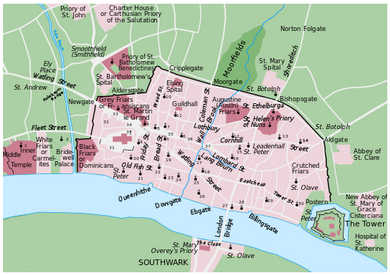 In the past this area was the abode of the Knights of the Templar, the military-monk order founded in 1118, after the first Crusade, under the name Pauperes commilitones Christitemplique Salomonis (Poor comrades in arms of Christ and the Temple of Solomon). Its members, also called the Red Templars due to the red crosses worn, were sworn to guarantee the safety of those who traveled to the Holy Land and protect the Holy Sepulchre. The order was suppressed by the Pope in 1312 and its properties passed over to the crown. Yet at the time of its greatest splendour, the company possessed many territories, such as mansions and fortress houses or harbour posts, from where they would control the English provinces and the Dalmatian coasts. In 1400, a part of the lands were rented to lawyers, who still occupy them today.
In the past this area was the abode of the Knights of the Templar, the military-monk order founded in 1118, after the first Crusade, under the name Pauperes commilitones Christitemplique Salomonis (Poor comrades in arms of Christ and the Temple of Solomon). Its members, also called the Red Templars due to the red crosses worn, were sworn to guarantee the safety of those who traveled to the Holy Land and protect the Holy Sepulchre. The order was suppressed by the Pope in 1312 and its properties passed over to the crown. Yet at the time of its greatest splendour, the company possessed many territories, such as mansions and fortress houses or harbour posts, from where they would control the English provinces and the Dalmatian coasts. In 1400, a part of the lands were rented to lawyers, who still occupy them today.The buildings contain shops and offices and enclose and protect the wonderful oasis of the Temple from the traffic, making it an island of silence where one can go for pleasant strolls.
PRINCE HENRY'S ROOM
17 FLEET STREET
UNDERGROUND: BLACKFRIARS
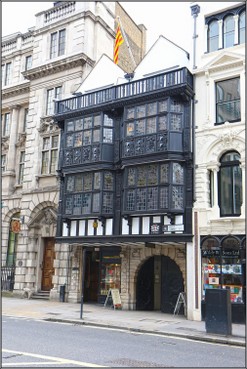 In the 12th Century, the building containing the room known as Prince Henry's Room belonged to the Templar Knights. At the time all houses were similar to it, however nowadays it is one of the few remaining examples. The beautiful front door with the timber frame, the Inner Temple Gateway, dates back to 1611. The room that bears the name of the oldest son of James I, who died of typhus fever at the age of eighteen, is on the first floor. The dressing of oak panels on the west side, the Jacobean ceiling with ribbing and the richly ornate plasterwork, typical of the 18th Century, are all original. At the centre of the star-shaped design of the ceiling, is the plume of the prince of Wales and his crest with the initials. Prince Henry was the oldest son of James I and his nomination as Prince of Wales in 1610 was the occasion for great celebrations. The window panes are from the Twentieth Century and are a reminder of when the building was saved from being demolished in 1906. It hosts a collection of memorabilia connected with the chronicler Samuel Pepys, who was born precisely in this street in 1635. The collection includes some of his manuscripts, some paintings, and printed material dedicated to him.
In the 12th Century, the building containing the room known as Prince Henry's Room belonged to the Templar Knights. At the time all houses were similar to it, however nowadays it is one of the few remaining examples. The beautiful front door with the timber frame, the Inner Temple Gateway, dates back to 1611. The room that bears the name of the oldest son of James I, who died of typhus fever at the age of eighteen, is on the first floor. The dressing of oak panels on the west side, the Jacobean ceiling with ribbing and the richly ornate plasterwork, typical of the 18th Century, are all original. At the centre of the star-shaped design of the ceiling, is the plume of the prince of Wales and his crest with the initials. Prince Henry was the oldest son of James I and his nomination as Prince of Wales in 1610 was the occasion for great celebrations. The window panes are from the Twentieth Century and are a reminder of when the building was saved from being demolished in 1906. It hosts a collection of memorabilia connected with the chronicler Samuel Pepys, who was born precisely in this street in 1635. The collection includes some of his manuscripts, some paintings, and printed material dedicated to him.In the 16th Century, behind the house stood the Prince's Arms tavern, which continued its activity until the Nineteenth Century, although with another name.
ROUND CHURCH
KING'S BENCH WAL
UNDERGROUND: TEMPLE
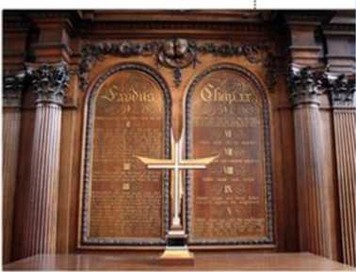 The model of this church with a circular layout is that of the Holy Sepulchre of Jerusalem, of which the Templars were the guardians. It was built between 1160 and 1185 in Romanesque-Gothic style and is the oldest part of Temple Church, which stood at the perimeter of the monastery. This is where the rite of initiation of the knights would take place , whose effigies have been placed on the paving.
The model of this church with a circular layout is that of the Holy Sepulchre of Jerusalem, of which the Templars were the guardians. It was built between 1160 and 1185 in Romanesque-Gothic style and is the oldest part of Temple Church, which stood at the perimeter of the monastery. This is where the rite of initiation of the knights would take place , whose effigies have been placed on the paving.Some of them are portrayed in a rather bizarre position. In the choir there is a monumental wooden altar designed by Wren at the end of the Eighteenth Century, where there is an engraving in gold letters of the Creed and the Ten Comandments. The gothic part of the choir was added in 1240 and harmoniously fits in with everything else. Outside are two bronze statues of Templars on horseback. On the Norman door there are some grotesque portraits of heads.
In the novel The da Vinci Code by Dan Brown, the Round Church is the place where the main characters search for the answer to the final riddle.
In William Shakespeare's Henry VI, instead, the author imagines that the Wars of the Roses had begun here and that it was set off precisely by the picking of two roses in the garden of the Temple. To commemorate this Shakespearean tradition, red roses and white roses were both planted near the wall in 2002.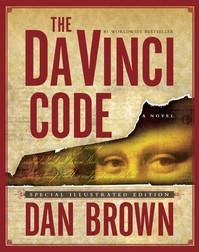 The Da Vinci Code - For those passionate about The Da Vinci Code, let us just say that the hunt continues at Westminster Abbey, at 20, Dean Yard, where Isaac Newton's tomb, bearing an orb, which makes up the clue for the following step. Also, Jean Cocteau, author of the Crucifixion found in the church of Notre-Dame de France at 5, Leicester Place, was Grand Master of the Priory of Sion and his painting contains occult symbols. Those interested may visit Freemasons Hall, at Covent Garden, of which the details are found in the pages dedicated to that area of the city.
The Da Vinci Code - For those passionate about The Da Vinci Code, let us just say that the hunt continues at Westminster Abbey, at 20, Dean Yard, where Isaac Newton's tomb, bearing an orb, which makes up the clue for the following step. Also, Jean Cocteau, author of the Crucifixion found in the church of Notre-Dame de France at 5, Leicester Place, was Grand Master of the Priory of Sion and his painting contains occult symbols. Those interested may visit Freemasons Hall, at Covent Garden, of which the details are found in the pages dedicated to that area of the city. 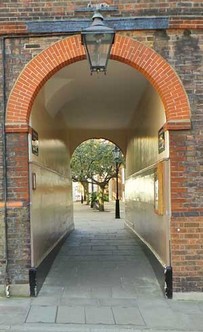 They are called Inns because of the fact that in the past they functioned as hostels, providing meals and lodging. The Inns of Court are actually professional associations which qualify professionals to practice law and forensics, and to which lawyers must necessarily belong. These associations supervise the conduct of members, which includes the category of the barristers, lawyers with rights of audience in higher courtrooms, who according to English law, do not usually have access to clients, and solicitors, to whom barristers are assigned. These locations are also used by benchers, the senior members of the Inns of Court. Each Inn has a vast hall, a chapel, and a library. In the City stand two of the four buildings of the Inns of Courts, Middle Temple and Inner Temple.
They are called Inns because of the fact that in the past they functioned as hostels, providing meals and lodging. The Inns of Court are actually professional associations which qualify professionals to practice law and forensics, and to which lawyers must necessarily belong. These associations supervise the conduct of members, which includes the category of the barristers, lawyers with rights of audience in higher courtrooms, who according to English law, do not usually have access to clients, and solicitors, to whom barristers are assigned. These locations are also used by benchers, the senior members of the Inns of Court. Each Inn has a vast hall, a chapel, and a library. In the City stand two of the four buildings of the Inns of Courts, Middle Temple and Inner Temple. 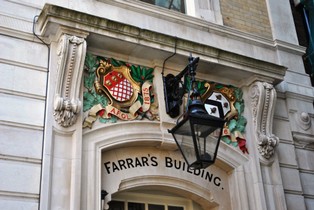 The other two, Lincoln's Inn, at Inns Fields, and Grey's Inn, in a street going by the same name, are instead a little to the north.
The other two, Lincoln's Inn, at Inns Fields, and Grey's Inn, in a street going by the same name, are instead a little to the north.A route for a nice walk could start off at Grey’s Inn and move towards the river, passing by Temple Church with its stone knights. On the Knight’s Bench Walk it feels like going back in time. It should be kept in mind that the area is always open during the religious service at Inner Temple Church, built on the area of a church of the Templars in the 12th Century.
MIDDLE TEMPLE HALL
MIDDLE TEMPLE LANE
UNDERGROUND: TEMPLE
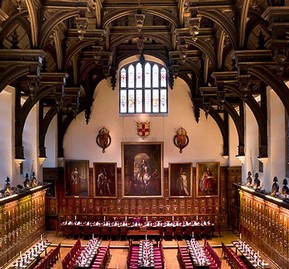 One arrives in Middle Temple Lane after having passed the Temple Bar Memorial, overlooked by a griffin, the symbol of the City. It is the only building to have survived since Shakespeare's days until now. The dining room of the Honourable Society of Temple Hall is a real jewel of the second half of the Sixteenth Century, with a splendid Tudor ceiling with cantilevered beams in oak wood. The bench table is a nine-meter-long stone bench, a present from Elizabeth I. It is said that in February 1602, Shakespeare used this hall to act out his comedy Twelfth Night. What is more, many poets and playwrights, amongst which John Webster, John Ford and John Marston, were once students at Middle Temple and one can just imagine them here, discussing legal matters. After the last war, the ancient labyrinth of courtyards and passages was rebuilt.
One arrives in Middle Temple Lane after having passed the Temple Bar Memorial, overlooked by a griffin, the symbol of the City. It is the only building to have survived since Shakespeare's days until now. The dining room of the Honourable Society of Temple Hall is a real jewel of the second half of the Sixteenth Century, with a splendid Tudor ceiling with cantilevered beams in oak wood. The bench table is a nine-meter-long stone bench, a present from Elizabeth I. It is said that in February 1602, Shakespeare used this hall to act out his comedy Twelfth Night. What is more, many poets and playwrights, amongst which John Webster, John Ford and John Marston, were once students at Middle Temple and one can just imagine them here, discussing legal matters. After the last war, the ancient labyrinth of courtyards and passages was rebuilt. 
The building adjoining Middle Temple is the home to the Honourable Society of the Inner Temple, which in the Eighteenth Century, had as many as one thousand six hundred students.
However, what one really cannot afford to miss are the gardens (which have been awarded more than a prize) between Fleet Street to the north and Victoria Embankment to the south. They are an oasis of greenery which descend towards the Thames, with rare trees and flowers to be admired. It is a peaceful place of refuge, where there are naturally a number of rules to be observed, starting from that of cleaning up one's own rubbish and taking it away with one. One of the entries is on Crown Office Row.
KING'S BENCH WALK
UNDERGROUND: TEMPLE
The walk gets its name from King's Ben Office, which until the Nineteenth Century, was located here.
Along this street there are very old buildings, which have survived wars and destruction. Those between number 1 and 6 were designed by Christopher Wren. It is a magical place to walk in the evening, whether in the winter or the summer. For this reason, the street is often used as an open set for films and television programs.
Everybody knows that London is a city with many sundials, of all shapes and sizes. Beyond a garden gate in this street there is a most peculiar one. It is the statue of a black child, crouching and holding a near horizontal sundial on his head. 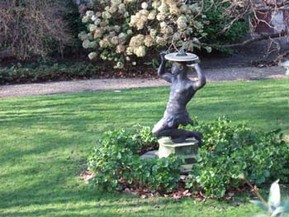 The statue and the solar clock have different dates of fabrication. The two parts were built with different purposes, and were later assembled together. There is also another sundial dated 1686 on the facade of the house with a garden just next to the Paper Buildings, in the nearby Pump Court, a small street which is evocative and enchanting. The phrase at the bottom recites: "Shadows we are and like shadows depart".
The statue and the solar clock have different dates of fabrication. The two parts were built with different purposes, and were later assembled together. There is also another sundial dated 1686 on the facade of the house with a garden just next to the Paper Buildings, in the nearby Pump Court, a small street which is evocative and enchanting. The phrase at the bottom recites: "Shadows we are and like shadows depart".
 The statue and the solar clock have different dates of fabrication. The two parts were built with different purposes, and were later assembled together. There is also another sundial dated 1686 on the facade of the house with a garden just next to the Paper Buildings, in the nearby Pump Court, a small street which is evocative and enchanting. The phrase at the bottom recites: "Shadows we are and like shadows depart".
The statue and the solar clock have different dates of fabrication. The two parts were built with different purposes, and were later assembled together. There is also another sundial dated 1686 on the facade of the house with a garden just next to the Paper Buildings, in the nearby Pump Court, a small street which is evocative and enchanting. The phrase at the bottom recites: "Shadows we are and like shadows depart". Temple is one of the areas which are still illuminated by gas street lights, as in other areas, such as in front of Buckingham Palace, along Queen's Walk in Green Park, in St James's Park and in front of St James's Palace, around Westminster palace and the abbey, along the Mail, at the Morse Guard Parade, in some of the streets near Covent Garden, in Charter House Square and Guildhall.
FOUNTAIN COURT
MIDDLE TEMPLEUNDERGROUND: TEMPLE, CHANCERY LANE
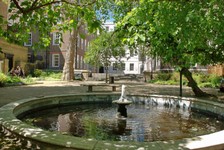 At the centre of the small square stands a fountain with a single central jet of water which spurts from a goblet and falls back into a basin abundant with goldfish. This square is one of the literary settings of London. It features in Dickens' Martin Chuzzlewit and has hosted Paul Verlaine during his stay in England
At the centre of the small square stands a fountain with a single central jet of water which spurts from a goblet and falls back into a basin abundant with goldfish. This square is one of the literary settings of London. It features in Dickens' Martin Chuzzlewit and has hosted Paul Verlaine during his stay in EnglandTHE TAXI DRIVERS' SHELTERS
TEMPLE PLACE
UNDERGROUND: TEMPLE
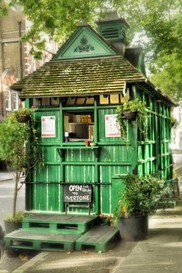 In the past, there were sixty-one little wooden huts which offered refuge and comfort to those busy all day driving taxis. They were all identical, with wooden walls made of wedged green panels, the ceilings lined in bituminized felt and the top of the roof covered in terracotta tiles. There was also a small dome for ventilation closed off with a lead cap. Of these shelters, only thirteen remain. It is interesting to visit the inside, spartan and essential, but providing all that one could need during a brief stop, like a good cup of coffee or piping hot tea, along with a sandwich or sweet snack. This small structure is located at the back of the underground station of Temple.
In the past, there were sixty-one little wooden huts which offered refuge and comfort to those busy all day driving taxis. They were all identical, with wooden walls made of wedged green panels, the ceilings lined in bituminized felt and the top of the roof covered in terracotta tiles. There was also a small dome for ventilation closed off with a lead cap. Of these shelters, only thirteen remain. It is interesting to visit the inside, spartan and essential, but providing all that one could need during a brief stop, like a good cup of coffee or piping hot tea, along with a sandwich or sweet snack. This small structure is located at the back of the underground station of Temple.On the same street, there is another oddity, a bin for sand. In the past, and in particular during the Edwardian period, the city streets would sport many of these sand containers, which were born with a noble intention. The grains of sand would pour out of an opening at the base and those in charge would shovel it out, and spread it on the surface of the road, near any houses where there had been a death in the family or where there were severely ill people, in order to silence the sound of horse hooves and cart wheels.

ST PAUL'S CATHEDRAL
LUDGATE HILL
UNDERGROUND: ST PAUL'S
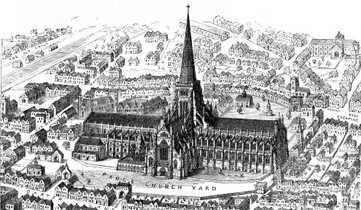 Since the year 640 there has been a church dedicated to St Paul in this place, although the buildings have been rebuilt a number of times after being destroyed by fires. The construction of 1240 has gone down in history as a place where witches and heretics were executed. The present day baroque building, dating back to 1675-1710, was designed by Wren in 1675 and has always hosted weddings and funerals for the royal family. For its construction, the English architect drew inspiration from the small temple of S. Pietro in Montorio in Rome, erected by Bramante in 1510 in the place where , according to tradition, St. Peter had become a martyr.
Since the year 640 there has been a church dedicated to St Paul in this place, although the buildings have been rebuilt a number of times after being destroyed by fires. The construction of 1240 has gone down in history as a place where witches and heretics were executed. The present day baroque building, dating back to 1675-1710, was designed by Wren in 1675 and has always hosted weddings and funerals for the royal family. For its construction, the English architect drew inspiration from the small temple of S. Pietro in Montorio in Rome, erected by Bramante in 1510 in the place where , according to tradition, St. Peter had become a martyr. 
St Paul's Cathedral is a very well-known symbol in London, therefore we will only give a few words of advice. Firstly, one can visit Painters' Corner, where , amongst others, the painters Constable, Reynolds, and Turner. The latter had a statue in the southern transept, among those of generals and admirals, and he is portrayed in a frock coat, with a painting brush in his hand.
A view from above - For anyone who feels up for it, a pleasant experience is that of climbing to the top of the dome. It is more than one thousand five hundred steps, being one of the largest in the world.
The inside part rests on eight arches held up by pillars decorated by frescos carried out in 1719, with scenes of the life of St. Paul.
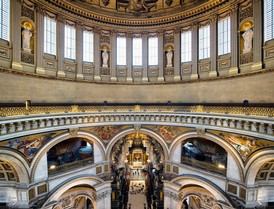 The first two hundred and fifty steps, quite wide and low, take one to the Whispering Gallery. The name is due to the fact that, thanks to the exceptional acoustics of the corridor, any whispers spoken towards the wall can be heard on the opposite side. A macebearer carries out the experiment for visitors. Also, from here one can clearly see the details of the paintings of the Thornhill dome, as well as the inlay work and the ironwork which cannot be admired from the ground. As one continues on up the steps, one reaches the Stone Gallery, which runs above the main tambour of the dome, near the brick cone and holds up the lantern. In order to reach the Golden Gallery, the tallest of the three, one must head up the last one hundred and fifty three steps of the narrow staircase. From up there, at almost 90 metres (300 feet) from the ground, one can witness a breathtaking panorama of the Thames and the City. There is also a small hole through which one can admire the church floor.
The first two hundred and fifty steps, quite wide and low, take one to the Whispering Gallery. The name is due to the fact that, thanks to the exceptional acoustics of the corridor, any whispers spoken towards the wall can be heard on the opposite side. A macebearer carries out the experiment for visitors. Also, from here one can clearly see the details of the paintings of the Thornhill dome, as well as the inlay work and the ironwork which cannot be admired from the ground. As one continues on up the steps, one reaches the Stone Gallery, which runs above the main tambour of the dome, near the brick cone and holds up the lantern. In order to reach the Golden Gallery, the tallest of the three, one must head up the last one hundred and fifty three steps of the narrow staircase. From up there, at almost 90 metres (300 feet) from the ground, one can witness a breathtaking panorama of the Thames and the City. There is also a small hole through which one can admire the church floor. Alternatively, there is a less-known part of the building, albeit it really is worth visiting. It is the Triforium, the gallery above the tribune, formed within the wall. The guided visit includes a look at the attractive library, covered in wooden panels, the sculpted arches, and the geometric staircase, where each step rests only on a part of the step below, and on a small connection with the wall. From the Triforium one can also see the nave below. 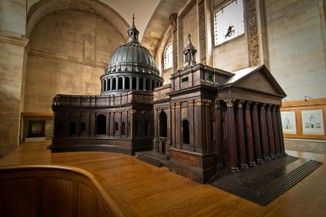 The visit ends in the Trophy Room, where there is an exhibition with a collection of items relating to the building of the cathedral, starting from a model of Wren's, based on an initial plan for the construction of the cathedral, with a Greek cross layout and a second dome. There are also some objects which have survived the fire which burnt the old cathedral, a beautiful bronze statue of a priest, and the bust of the dean William Ralph Inge, known by the nickname 'the sad dean' because of his pessimism. It is said that he made a habit of reading crime novels whilst attending mass.
The visit ends in the Trophy Room, where there is an exhibition with a collection of items relating to the building of the cathedral, starting from a model of Wren's, based on an initial plan for the construction of the cathedral, with a Greek cross layout and a second dome. There are also some objects which have survived the fire which burnt the old cathedral, a beautiful bronze statue of a priest, and the bust of the dean William Ralph Inge, known by the nickname 'the sad dean' because of his pessimism. It is said that he made a habit of reading crime novels whilst attending mass.
 The visit ends in the Trophy Room, where there is an exhibition with a collection of items relating to the building of the cathedral, starting from a model of Wren's, based on an initial plan for the construction of the cathedral, with a Greek cross layout and a second dome. There are also some objects which have survived the fire which burnt the old cathedral, a beautiful bronze statue of a priest, and the bust of the dean William Ralph Inge, known by the nickname 'the sad dean' because of his pessimism. It is said that he made a habit of reading crime novels whilst attending mass.
The visit ends in the Trophy Room, where there is an exhibition with a collection of items relating to the building of the cathedral, starting from a model of Wren's, based on an initial plan for the construction of the cathedral, with a Greek cross layout and a second dome. There are also some objects which have survived the fire which burnt the old cathedral, a beautiful bronze statue of a priest, and the bust of the dean William Ralph Inge, known by the nickname 'the sad dean' because of his pessimism. It is said that he made a habit of reading crime novels whilst attending mass. As a prize for the effort, one can head over to the bar and restaurant in the church crypt. It is cosy, spacious, and well-supplied with organic food products, and ideal for a snack with an inviting slice of homemade cake and a lovely cup of tea or coffee.
ST PAUL'S FOUNTAIN
ST PAUL'S CHURCHYARDUNDERGROUND: ST PAUL'S
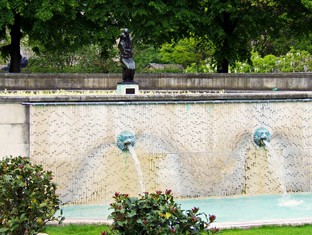 Fountains have changed incredibly through the years! The first had a merely practical functionality; later came symbolic decorations or water pouring out of lion's jaws, others had the shape of small temples; some had many varying jets of water or were embellished with statues... they became widespread especially in the Nineteenth Century when they were used for decorating squares and gardens St Paul's Fountain is a modern fountain with drinkable water, which provides water for tourists' bottles and locals, to quench their thirst and avoid the generation of mountains of plastic bottles. The water is greatly controlled and is of the highest quality. It has been placed near the information centre, in front of the cathedral. Hopefully, other fountains with drinkable water will gradually be restored around the city.
Fountains have changed incredibly through the years! The first had a merely practical functionality; later came symbolic decorations or water pouring out of lion's jaws, others had the shape of small temples; some had many varying jets of water or were embellished with statues... they became widespread especially in the Nineteenth Century when they were used for decorating squares and gardens St Paul's Fountain is a modern fountain with drinkable water, which provides water for tourists' bottles and locals, to quench their thirst and avoid the generation of mountains of plastic bottles. The water is greatly controlled and is of the highest quality. It has been placed near the information centre, in front of the cathedral. Hopefully, other fountains with drinkable water will gradually be restored around the city.BRACKEN HOUSE
1, FRIDAY STREET
UNDERGROUND: MANSION HOUSE
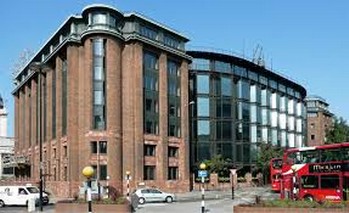 Until 1980 the newspaper The Financial Times, of which Bernard Bracken was the president, was published in this building, which stands in the area south of the cathedral. Bracken had also been the Information minister of Winston Churchill's war cabinet. The building, built between 1955 and 1959, south of the cathedral, was one of the first to be catalogued amongst those to be defended, and thus, also after being restructured, it conserved its rounded facade.
Until 1980 the newspaper The Financial Times, of which Bernard Bracken was the president, was published in this building, which stands in the area south of the cathedral. Bracken had also been the Information minister of Winston Churchill's war cabinet. The building, built between 1955 and 1959, south of the cathedral, was one of the first to be catalogued amongst those to be defended, and thus, also after being restructured, it conserved its rounded facade. TEMPLE BAR
PATERNOSTER SQUARE
UNDERGROUND: ST PAUL'S
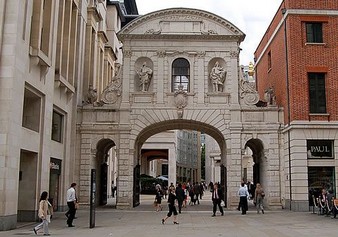 Temple Bar is a city gate in Portland stone with the symbol of a dragon above, which used to be in the point where Fleet Street became The Strand and marked the border between the City and Westminster. Once this portal was as familiar as St Paul's Cathedral is today. Perhaps its elaborate architecture made of recesses, statues, and horns of plenty around the central arch were designed by Wren and completed in 1672. After that it became a point of reference also for processions and ceremonies, as well as a place to exhibit the severed heads of traitors. In 1878 the portal was disassembled so that it could be temporarily moved to a cross street of Farrigdon Street and ten years later it was bought by the brewer Henry Meux, who had it installed in his Theobolds estate, at the centre of a clearing in the middle of the woods, where it had a rather incongruous appearance. Inside it, a time capsule was placed, with some Nineteenth Century newspapers, some coins, and a page of the Sporting Times dated January, 7th of the that year. In 1984, a good one hundred and twenty-five years later, it was relocated to its original spot, in Paternoster Square, where it makes a good show of itself.
Temple Bar is a city gate in Portland stone with the symbol of a dragon above, which used to be in the point where Fleet Street became The Strand and marked the border between the City and Westminster. Once this portal was as familiar as St Paul's Cathedral is today. Perhaps its elaborate architecture made of recesses, statues, and horns of plenty around the central arch were designed by Wren and completed in 1672. After that it became a point of reference also for processions and ceremonies, as well as a place to exhibit the severed heads of traitors. In 1878 the portal was disassembled so that it could be temporarily moved to a cross street of Farrigdon Street and ten years later it was bought by the brewer Henry Meux, who had it installed in his Theobolds estate, at the centre of a clearing in the middle of the woods, where it had a rather incongruous appearance. Inside it, a time capsule was placed, with some Nineteenth Century newspapers, some coins, and a page of the Sporting Times dated January, 7th of the that year. In 1984, a good one hundred and twenty-five years later, it was relocated to its original spot, in Paternoster Square, where it makes a good show of itself. TAVERN ABOVE, PRISON BELOW
126, NEWGATE STREET
UNDERGROUND: ST PAUL'S
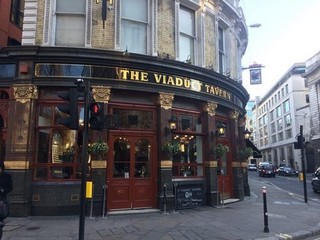 In the Newgate prison, which once stood here and remained active for many a century, today all that remains is the cluster of underground cells. The Viaduct Tavern, which is above, is an example of a splendid Victorian venue, with a large curved facade. Inside there are gilded mirrors, a wooden structure jutting into the venue, a pretty clock, the ceiling in tin-plated copper, the wooden covering and the three allegorical female figures who represent Agriculture, Trade, and the Arts. The latter of the three, according a legend, was once vandalized by a drunken soldier during the First World War, and one can still see the mark of the bayonet.
In the Newgate prison, which once stood here and remained active for many a century, today all that remains is the cluster of underground cells. The Viaduct Tavern, which is above, is an example of a splendid Victorian venue, with a large curved facade. Inside there are gilded mirrors, a wooden structure jutting into the venue, a pretty clock, the ceiling in tin-plated copper, the wooden covering and the three allegorical female figures who represent Agriculture, Trade, and the Arts. The latter of the three, according a legend, was once vandalized by a drunken soldier during the First World War, and one can still see the mark of the bayonet. 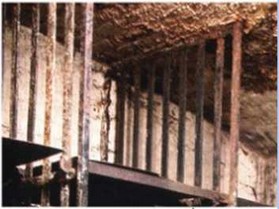 The viaduct was opened the same year as the Holborn viaduct, opened by Queen Victoria in 1869.
The viaduct was opened the same year as the Holborn viaduct, opened by Queen Victoria in 1869. One reaches the old cells of the prison through a passage which has printings from past epochs hung up on its walls, and the cells are humid, cold, and dark and the iron bars are rusted. They used to hold about twenty criminals, there were no bathrooms, thus the stench must have been unbearable, and there was a small duct leading onto the road for food to be passed down to the prisoners, thus anyone who could not pay for food would go hungry. It is said that these cells are haunted by ghosts, and the pub workers swear they have witnessed signs of this presence. To visit the cells one must ask one of them.
On the same road we find the garden of Christchurch Greyfriars, with a rose garden which lies between the ruins of a church built by Wren in 1704 and partly destroyed by the bombing during the war. With a little imagination, the layout of the plants can remind one of that of the church. In the place of the benches there are bushes and flowerbeds, and the towers covered in roses and clematis resemble the pillars which separated the naves.
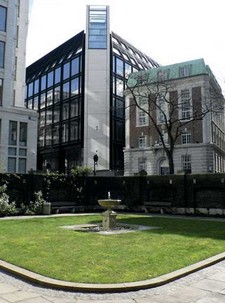 Many centuries ago, at the corner of the nearby Gresham Street with Aldersgate Street, stood the church of St John Zachary, later destroyed by the Great Fire. Today this area has been transformed into a garden, and upon its gate some leopard heads have been portrayed, an instalment carried out under the Company of Goldsmiths, which took care of the restoration. The company is one of the twelve large corporations of the City, which starting in 1300, when gold and silver were marked with a leopard's head, was in charge of the application of this trademark of guarantee. Still today the leopard is the mark impressed on samples to be tested and found on the Goldsmiths' crest.
Many centuries ago, at the corner of the nearby Gresham Street with Aldersgate Street, stood the church of St John Zachary, later destroyed by the Great Fire. Today this area has been transformed into a garden, and upon its gate some leopard heads have been portrayed, an instalment carried out under the Company of Goldsmiths, which took care of the restoration. The company is one of the twelve large corporations of the City, which starting in 1300, when gold and silver were marked with a leopard's head, was in charge of the application of this trademark of guarantee. Still today the leopard is the mark impressed on samples to be tested and found on the Goldsmiths' crest. 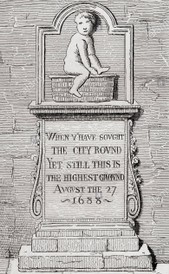 Ludgate is one of the most ancient historical areas in town, alongside Cornhill. Where St Paul's Cathedral stands today, the Romans had built an amphitheatre and a fort. In the past it was believed that Ludgate Hill, whose name derives from the legendary English monarch King Lud, was taller than Cornhill. This is confirmed by an engraving on a three-hundred-year-old stone, on the left of the entry to the Panyer Alley Steps, near the underground station of St Paul. The phrase states: "When ye have sought the City round, yet still this is the highest ground. August 27th 1688". This is however not true, because, as discovered later on, Cornhill is actually taller, albeit only by a small amount.
Ludgate is one of the most ancient historical areas in town, alongside Cornhill. Where St Paul's Cathedral stands today, the Romans had built an amphitheatre and a fort. In the past it was believed that Ludgate Hill, whose name derives from the legendary English monarch King Lud, was taller than Cornhill. This is confirmed by an engraving on a three-hundred-year-old stone, on the left of the entry to the Panyer Alley Steps, near the underground station of St Paul. The phrase states: "When ye have sought the City round, yet still this is the highest ground. August 27th 1688". This is however not true, because, as discovered later on, Cornhill is actually taller, albeit only by a small amount.Here we find the halls of a few corporations and the building which hosts the Old Bailey.
CHURCH OF ST MARTIN-WITHIN-LUDGATE
38-40 LUDGATE HILL
UNDERGROUND: ST PAUL'S
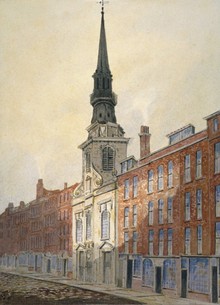 The church, dedicated to St. Martin of Tours, stands on the north side of Ludgate Hill, near St Paul's Cathedral. On the facade there is written notice which refers to the legendary King Cadwallon ap Cadfan, which states: “It is maintained that Cadwallon, King of the Britons, was buried here in 677.” In 1684, Christopher Wren reconstructed the building, which has a square tower with a dome covered with a layer of lead, surmounted by a lantern within a steeple in the shape of an obelisk. Those who decide to head up to the balcony are rewarded with a wonderful view of the river. The great chandelier which hangs from the centre of the ceiling comes from the West Indies, whereas the baptismal font, instead, has an engraving in Greek: "Cleanse my sins , not just my face". At the base is a pelican feeding its young with blood from its own chest.
The church, dedicated to St. Martin of Tours, stands on the north side of Ludgate Hill, near St Paul's Cathedral. On the facade there is written notice which refers to the legendary King Cadwallon ap Cadfan, which states: “It is maintained that Cadwallon, King of the Britons, was buried here in 677.” In 1684, Christopher Wren reconstructed the building, which has a square tower with a dome covered with a layer of lead, surmounted by a lantern within a steeple in the shape of an obelisk. Those who decide to head up to the balcony are rewarded with a wonderful view of the river. The great chandelier which hangs from the centre of the ceiling comes from the West Indies, whereas the baptismal font, instead, has an engraving in Greek: "Cleanse my sins , not just my face". At the base is a pelican feeding its young with blood from its own chest.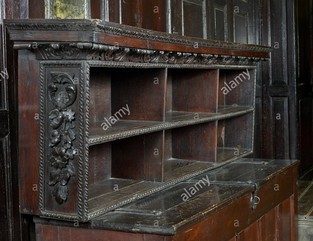 It is in this building that they conserve the shelves from the church of St Magdalene, which used to be in Old Fish Street, and upon which, in the Eighteenth and Nineteenth century, one would leave bread for the poor people of the parish. There is still bread here, but it is fake. The pulpit, the balustrades, and the altar are particularly exquisite. Above the altar there is a triptych with the figure of St Martin sharing his cape with a beggar. Some stones which come from the old walls of London have been inserted into the walls of the vestry.
It is in this building that they conserve the shelves from the church of St Magdalene, which used to be in Old Fish Street, and upon which, in the Eighteenth and Nineteenth century, one would leave bread for the poor people of the parish. There is still bread here, but it is fake. The pulpit, the balustrades, and the altar are particularly exquisite. Above the altar there is a triptych with the figure of St Martin sharing his cape with a beggar. Some stones which come from the old walls of London have been inserted into the walls of the vestry. 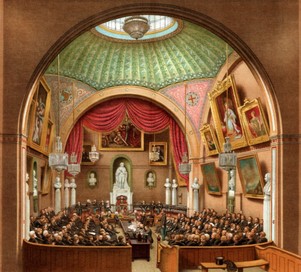 During the Middle Age, men who performed the same craft or were involved in the same line of trade were grouped in associations aimed at safeguarding their interests and regulating the conduct of their activities. London had over one hundred guilds, often tied to religious associations, which guaranteed a suitable burial for members and services for the deceased. The craft guilds decided who could enter and become a part of them, they controlled prices, salaries, working conditions, and punished those who did not work appropriately or who were disonest, and they also carried out a form of quality control. In exchange they had a right to monopoly over goods.
During the Middle Age, men who performed the same craft or were involved in the same line of trade were grouped in associations aimed at safeguarding their interests and regulating the conduct of their activities. London had over one hundred guilds, often tied to religious associations, which guaranteed a suitable burial for members and services for the deceased. The craft guilds decided who could enter and become a part of them, they controlled prices, salaries, working conditions, and punished those who did not work appropriately or who were disonest, and they also carried out a form of quality control. In exchange they had a right to monopoly over goods. In the City the guilds absorbed political power and their wealth was immense. The most powerful was that of the Goldsmiths, already existing in at the beginning of the Fourteenth Century, which controlled the forging of coins and precious goods. It also carried out the role of a bank and guarded money before financial institutes appeared, at the beginning of the NIneteenth Century.
The shidting of power from the artisan to rich merchants brought about the decline of the guilds. However they did not disappear altogether, but their function changed. Today they sustain philanthropic associations and schools, and also organize dinners for fundraising in their headquarters. About forty guild halls are open to the public, usually during working days, and are worth a visit because they are magnificent to see. Also the buildings they reside in, especially those built before 1830, have excellent architectural qualities.

Among books and knives - The booksellers' palace Stationers' Hall, stands in Ave Maria lane, one of the small roads around St Paul's, all of which have prayer-related names. Other examples are Amen Court, Amen Corner, Creed Lane and Paternoster Row. Ave Maria Lane was one of the places where processions would pass and stop briefly, and because of this, a number of small religious text and prayer shops were found here. The headquarters of the guilds of the four P's: print, publishing, paper, and packaging, are marked on a signpost. It has existed since the Fifteenth Century, when published books had to be registered in this location. This procedure ceased in 1710. Today, between the wooden-covered walls of the great hall, wedding receptions and dinners take place, and their profit is given to various charities.
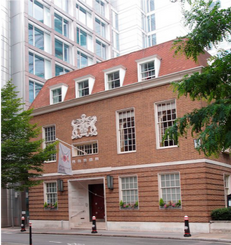 At number 4 of the nearby Warwick Lane, is the knifemakers' building, Cutlers’ Hall, which is also the oldest of the City. The word cutler derives from the Latin word cultellarius and the products of the cutlers ranged from weaponry to domestic items, such as knives, scissors, and razors. Their job was based on teamwork: designers would plan the shapes of the items and the images to represent on them, and craftsmen would include gilders, sharpeners, and polishers. In the guild cemetery there stand two elephants, which hint at the ivory used in the past for precious marquetry.
At number 4 of the nearby Warwick Lane, is the knifemakers' building, Cutlers’ Hall, which is also the oldest of the City. The word cutler derives from the Latin word cultellarius and the products of the cutlers ranged from weaponry to domestic items, such as knives, scissors, and razors. Their job was based on teamwork: designers would plan the shapes of the items and the images to represent on them, and craftsmen would include gilders, sharpeners, and polishers. In the guild cemetery there stand two elephants, which hint at the ivory used in the past for precious marquetry. OLD BAILEY
OLD BAILEY
UNDERGROUND: ST PAUL'S
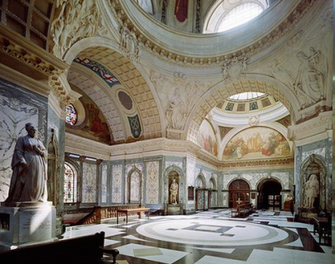 The word bailey indicates the outer walls, the bastions of a city. Old Bailey is the name of the street that gives the central criminal court its name, erected in the area of Newgate prison. The dome of the building, built at the beginning of the Twentieth Century, is overlooked by the statue of Justice with the sword and scales.
The word bailey indicates the outer walls, the bastions of a city. Old Bailey is the name of the street that gives the central criminal court its name, erected in the area of Newgate prison. The dome of the building, built at the beginning of the Twentieth Century, is overlooked by the statue of Justice with the sword and scales.The sculpture is not blindfolded, as one usually would expect, and those condemned would often complain that this was a sign of the discrimination of the judges. One of the most famous characters to be indicted was the writer Oscar Wilde, condemned to two years of forced labour, to be carried out in Reading Prison.
In 2005 the initial scene of the thriller V for Vendetta was shot in front of the Old Bailey; it is based on the homonymous book by Alan Moore and David Lloyd. The film envisages a totalitarian and dystopian society set in 2038, characterized by excessive state control. The main character, the mysterious V, fights for freedom and wishes to change society, as well as fulfilling his personal revenge at the same time. To do this he devises a plan to blow up the Old Bailey. The regime explains that this course of action had become necessary because of an emergency, yet V manages to take control of the British Television Network and demonstrate that this is in fact a lie.

NATIONAL POSTAL MUSEUM
KING EDWARD STREET
UNDERGROUND: ST PAUL'S
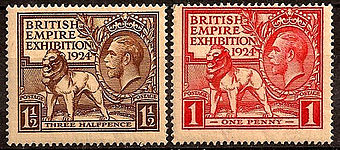 Stamps are an English invention, as it was in fact King Charles I to open his personal postal service to the public. In 1657, under Cromwell's reign. the first General Post Office was created. The museum, which is near the Cathedral and the London Museum, was opened in 1966 in what was the headquarters of the General Post Office during the Nineteenth Century, in an area of the church of St Martin's Le Grand. It hosts a collection of three hundred and fifty thousand stamps from all over the world, as well as illustrations by artists, books, and documents relating to stamp collecting. It was founded under the suggestion of the stamp collector Reginald M. Phillips, who donated his huge collection of stamps from the Nineteenth Century to the nation. Their arrangement is quite ingenious. Today, as the British Library does with books, the museum hosts a copy of each stamp printed in the United Kingdom, therefore one can find all those printed in current times.
Stamps are an English invention, as it was in fact King Charles I to open his personal postal service to the public. In 1657, under Cromwell's reign. the first General Post Office was created. The museum, which is near the Cathedral and the London Museum, was opened in 1966 in what was the headquarters of the General Post Office during the Nineteenth Century, in an area of the church of St Martin's Le Grand. It hosts a collection of three hundred and fifty thousand stamps from all over the world, as well as illustrations by artists, books, and documents relating to stamp collecting. It was founded under the suggestion of the stamp collector Reginald M. Phillips, who donated his huge collection of stamps from the Nineteenth Century to the nation. Their arrangement is quite ingenious. Today, as the British Library does with books, the museum hosts a copy of each stamp printed in the United Kingdom, therefore one can find all those printed in current times.
Also present is the Penny Black, issued on May 1st, 1840, the first official stamp to be used in the world, named so because at the time its value was of one penny and because the effigy of the Queen was on a black background. It was used for little more than one year, because the postmark in red ink was not easily visible and the ink was easily removed.
The museum also holds an extraordinary collection of old post boxes, which in this country are quite remarkable and carefully crafted. A special exhibition covers the history and evolution of transport and the distribution of post throughout past centuries.
POSTMAN'S PARK
KING EDWARD STREET
UNDERGROUND: ST PAUL'S
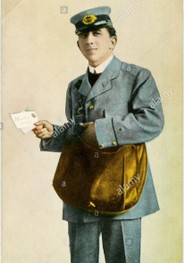 The small but gracious Postmans Park owes its name to the fact that during lunch breaks, it would fill up with workers from the nearby post office, which no longer exists today. The park, however, continues to be populated by workers who come here to eat lunch. This green oasis at the centre of the City, made all the more lively by a fountain, was born from the idea of the painter and philanthropist George Watts. He was a person sensitive to the terrible living conditions of poor people, and did not hold back from criticising the meanness of the upper class and who, as the good socialist he was, always refused the title of baron.
The small but gracious Postmans Park owes its name to the fact that during lunch breaks, it would fill up with workers from the nearby post office, which no longer exists today. The park, however, continues to be populated by workers who come here to eat lunch. This green oasis at the centre of the City, made all the more lively by a fountain, was born from the idea of the painter and philanthropist George Watts. He was a person sensitive to the terrible living conditions of poor people, and did not hold back from criticising the meanness of the upper class and who, as the good socialist he was, always refused the title of baron. 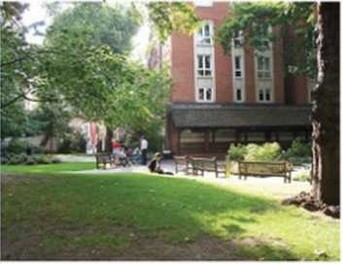 He created a small gallery along the walls of the old cemetery, formed by a series of Doulton plaques upon which the heroism of unknown men and women is commemorated, having given their lives in the attempt to save the lives of others. As well as their names, amid the bay leaves, the plaques tell us about what type of situation these people acted upon. Watts had time to put up thirteen of them, then his wife saw to adding another thirty-four. Some of the episodes mentioned involved children in railway accidents, others instead refer to drownings or fires. The tone of the accounts is somewhat rhetorical and sentimental, One phrase pronounced by a eleven year old boy who died to save his younger brother, directed at his mother, recites: "Mother, I saved him, but I could not save myself".
He created a small gallery along the walls of the old cemetery, formed by a series of Doulton plaques upon which the heroism of unknown men and women is commemorated, having given their lives in the attempt to save the lives of others. As well as their names, amid the bay leaves, the plaques tell us about what type of situation these people acted upon. Watts had time to put up thirteen of them, then his wife saw to adding another thirty-four. Some of the episodes mentioned involved children in railway accidents, others instead refer to drownings or fires. The tone of the accounts is somewhat rhetorical and sentimental, One phrase pronounced by a eleven year old boy who died to save his younger brother, directed at his mother, recites: "Mother, I saved him, but I could not save myself".ST BOTOLPH'S CHURCH
ALDERSGATE STREET
UNDERGROUND: ST PAUL'S
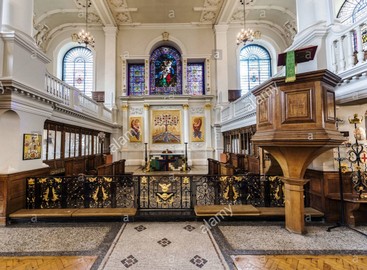 Very little is known about the life of St Botolph or Botulph, who died in 680. Some historical quotes connect him with Suffolk, in East Anglia, where most of the seventy churches dedicated to him reside. He is the patron saint of travellers and the four chapels of London with his name are all near the city gates. People arriving would go and thank him for having made it there safe and sound, those leaving would go and ask for his intercession for a journey without peril. The church had escaped the Great fire of 1666 unscathed, only to fall into ruin by 1790, when it was finally rebuilt in bricks, decorated with wedges of white stone all around the windows, and a small tower. Above the altar, there is a lovely glass wall from the Nineteenth Century, the only one of its kind that remains in the city.
Very little is known about the life of St Botolph or Botulph, who died in 680. Some historical quotes connect him with Suffolk, in East Anglia, where most of the seventy churches dedicated to him reside. He is the patron saint of travellers and the four chapels of London with his name are all near the city gates. People arriving would go and thank him for having made it there safe and sound, those leaving would go and ask for his intercession for a journey without peril. The church had escaped the Great fire of 1666 unscathed, only to fall into ruin by 1790, when it was finally rebuilt in bricks, decorated with wedges of white stone all around the windows, and a small tower. Above the altar, there is a lovely glass wall from the Nineteenth Century, the only one of its kind that remains in the city.CHURCH OF ST SEPULCHRE- WITHOUT- NEWGATE
SNOW HILL corner with HOLBORN VIADUCT
UNDERGROUND: ST PAUL'S
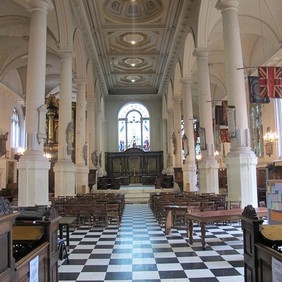 The church was given its name at the time of the crusades, when it was also known as the Church of the Holy Sepulchre. Without Newgate means "outside the walls". It was rebuilt halfway through the Sixteenth Century, however the fire of London in 1666 destroyed it. All that remains of the medieval period is the tower and the porch. Later, in the Nineteenth Century, a panelled ceiling was added. One of the four glass windows in the north part of the church, which was previously a chapel used for musical purposes, commemorates the opera singer Nellie Melba. In a glass shrine, a bell has been preserved, which used to be used for announcing the execution of a prisoner sentenced to death in the nearby prison of Newgate.
The church was given its name at the time of the crusades, when it was also known as the Church of the Holy Sepulchre. Without Newgate means "outside the walls". It was rebuilt halfway through the Sixteenth Century, however the fire of London in 1666 destroyed it. All that remains of the medieval period is the tower and the porch. Later, in the Nineteenth Century, a panelled ceiling was added. One of the four glass windows in the north part of the church, which was previously a chapel used for musical purposes, commemorates the opera singer Nellie Melba. In a glass shrine, a bell has been preserved, which used to be used for announcing the execution of a prisoner sentenced to death in the nearby prison of Newgate.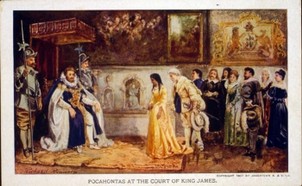 The legend of Pocahontas - The church also has a connection with captain John Smith and Pocahontas. In 2003, the American writer of crime novels, Patricia Cromwell, offered to sponsor a stained glass pane dedicated to Pocahontas, and in doing so set off a hornet's nest of controversy, and in the end a more generalized subject was chosen. The Disney version of the love story featuring an indigenous princess is legendary and mostly an invention. According to this version, captain John Smith, who had set out from the quay south of the church and had founded the state of Virginia, was condemned to death by order of chief Powhatan of the Mattaponi tribe. The sentence was about to be carried out and his head crushed with an enormous boulder, when Pocahontas, eleven-year-old daughter of the tribe chief, rested her head over that of Smith, saving his life. The real Pocahontas, who married the Englishman John Rolfe and converted to Christianity, died during the journey towards London in 1617, at the age of twenty-two, and is buried in Gravesend in Kent.
The legend of Pocahontas - The church also has a connection with captain John Smith and Pocahontas. In 2003, the American writer of crime novels, Patricia Cromwell, offered to sponsor a stained glass pane dedicated to Pocahontas, and in doing so set off a hornet's nest of controversy, and in the end a more generalized subject was chosen. The Disney version of the love story featuring an indigenous princess is legendary and mostly an invention. According to this version, captain John Smith, who had set out from the quay south of the church and had founded the state of Virginia, was condemned to death by order of chief Powhatan of the Mattaponi tribe. The sentence was about to be carried out and his head crushed with an enormous boulder, when Pocahontas, eleven-year-old daughter of the tribe chief, rested her head over that of Smith, saving his life. The real Pocahontas, who married the Englishman John Rolfe and converted to Christianity, died during the journey towards London in 1617, at the age of twenty-two, and is buried in Gravesend in Kent. The church is also known for the quality of its music.
A DISASTROUS SIN OF GLUTTONY
COCK LANE
UNDERGROUND: ST PAUL'S, CHANCERY
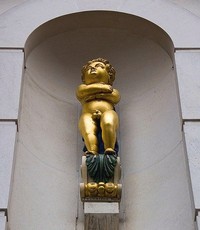 At the corner of Cock Lane with Giltspur Street in Smithfield there is a small golden statue of a boy. It has been placed in the most extreme region reached by the London fire of 1666. The engraving below states: “This Boy is in Memmory Put up for the late Fire of London Occasion'd by the Sin of Gluttony". Originally the statue was in front of the pub The Fortune of War, a gathering point for men who sought out cadavers from the nearby hospital of St Bartholomew's. The hunt for the guilty person had put the lives of many at risk. A crazed mob first wanted to hang a French goldsmith, then later an astrologer who had predicted the destruction of the city, and later still the Catholics. Finally and fortunately the cause was generically attributed to the sin of gluttony, for which the Great Fire was said to represent the punishment. At number 22 of the nearby Fleet Street, in a house with a very narrow facade which used to host a bank, sits the Olde Cock Tavern, a historical pub which is worth seeing, with a nice fireplace and a mantelpiece in Seventeenth Century oak. It was famous for the first breakfasts served in the very early morning to market workers.
At the corner of Cock Lane with Giltspur Street in Smithfield there is a small golden statue of a boy. It has been placed in the most extreme region reached by the London fire of 1666. The engraving below states: “This Boy is in Memmory Put up for the late Fire of London Occasion'd by the Sin of Gluttony". Originally the statue was in front of the pub The Fortune of War, a gathering point for men who sought out cadavers from the nearby hospital of St Bartholomew's. The hunt for the guilty person had put the lives of many at risk. A crazed mob first wanted to hang a French goldsmith, then later an astrologer who had predicted the destruction of the city, and later still the Catholics. Finally and fortunately the cause was generically attributed to the sin of gluttony, for which the Great Fire was said to represent the punishment. At number 22 of the nearby Fleet Street, in a house with a very narrow facade which used to host a bank, sits the Olde Cock Tavern, a historical pub which is worth seeing, with a nice fireplace and a mantelpiece in Seventeenth Century oak. It was famous for the first breakfasts served in the very early morning to market workers. PAST AND PRESENT AT SMITHFIELD MARKET
CHARTERHOUSE STREET
UNDERGROUND: FARRINGDON, BARBICAN
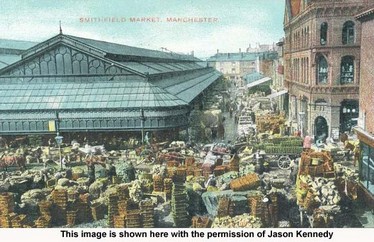 Smithfield, located in the Farringdon area, was known for its meat market for centuries. Today it remains the only historical wholesale market in the centre of London. At Smithfield, fairs and tournaments would often take place as well. The most famous of these was the one organized by Geoffrey Chaucer by order of King Richard II. The contest would last two days and about sixty knights would take part. In 1381 a young King Richard II had faced the revolt of the farmers led by Wat Tyler, who was hit and killed by the lord mayor, William Walworth. After the year 1400, Smithfield also became a place where executions were carried out against heretics and political opposers, who were burned inside a barrel beneath which a fire had been lit with bundles of wood. Also the Scottish patriot William Wallace was executed here in 1305.
Smithfield, located in the Farringdon area, was known for its meat market for centuries. Today it remains the only historical wholesale market in the centre of London. At Smithfield, fairs and tournaments would often take place as well. The most famous of these was the one organized by Geoffrey Chaucer by order of King Richard II. The contest would last two days and about sixty knights would take part. In 1381 a young King Richard II had faced the revolt of the farmers led by Wat Tyler, who was hit and killed by the lord mayor, William Walworth. After the year 1400, Smithfield also became a place where executions were carried out against heretics and political opposers, who were burned inside a barrel beneath which a fire had been lit with bundles of wood. Also the Scottish patriot William Wallace was executed here in 1305.
The great Victorian structure of the covered marketplace, built in the second half of the Nineteenth Century, is by the architect Horace Jones.
Today's events are of quite a different kind and include, for example, a night-time bicycle race known as Smithfìeld Nocturne. In this area, there is also a great number of night clubs, amongst which the Fabric, at 77, Charterhouse Street, right in front of the market, where fashion modeling, exhibitions, and workshops take place as well. Amongst the numerous restaurants of the area, the St John, at number 26 of St John's Street has an interesting history behind it.
CLOTH FAIR
UNDERGROUND: BARBICAN, FARRINGDON
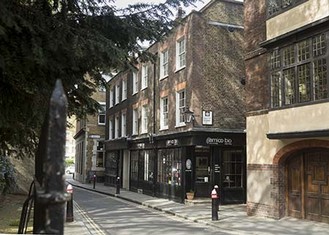 A walk between two markets - The Smithfield Market could be an arrival point for an interesting walk between two marketplaces. Starting from Leadenhall Market, in Whittington Avenue, you can head towards Postmans Park, in King Edward Street, where you can rest a little and read some of the plaques dedicated to the unknown war heroes. You can then head over to the ancient and beautiful church of St Bartholemew the Great, in West Smithfield, and conclude the route at Smithfield Market or, if you wish, at the Jerusalem Tavern, at 55,Britton Street.
A walk between two markets - The Smithfield Market could be an arrival point for an interesting walk between two marketplaces. Starting from Leadenhall Market, in Whittington Avenue, you can head towards Postmans Park, in King Edward Street, where you can rest a little and read some of the plaques dedicated to the unknown war heroes. You can then head over to the ancient and beautiful church of St Bartholemew the Great, in West Smithfield, and conclude the route at Smithfield Market or, if you wish, at the Jerusalem Tavern, at 55,Britton Street.In the days of monasteries, this area was known as the green part of the market, and the enclosure formed by the textile stands was known as Our Lady's Green. The surrounding houses were all inhabited by traders of fabric, cloth and other textile products. The first textile fair took place in August 1133, near the monastery of St Bartholomew. Tailors and cloth merchants would hurry over from every corner of the country to perform their craft and trade. The I functionaries of the guild controlled the length of the pieces sold with a small rod which was one yard long. Any lawbreakers found cheating were taken to the nearby brewery Hand and Shears, judged in front of a court at the top floor, then immobilized in wooden stocks and whipped.

The last market took place in 1855 and, until then, the bazaar was one of the most important ones in the city. Keeping the memory of Cloth Fair alive, is the name of the street that runs beside the church and which has some rather evocative houses, remnants which survived the bombing and the development plans of real estate agencies. The poet John Betjeman, as we are reminded by the blue sign-plate on the house, lived at number 41-42 of Cloth Fair. The building dates back to the end of the Sixteenth Century and still today conserves its rustic appearance. At the ground floor there is an Italian vegetarian restaurant, Amico Bio. Fresh organic food is delivered directly from Italy. The dishes are quite innovative and their presentation is also pleasing.
CHURCH OF ST BARTHOLOMEW'S THE GREAT
WEST SMITHFIELD
UNDERGROUND: BARBICAN
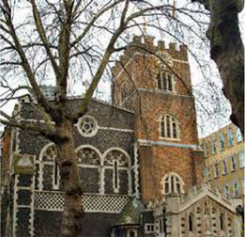 It is one of the most ancient churches of London, with a Medieval entrance which is a real jewel. A third of the building was once that of a Norman monastery, founded in 1123 by the monk known as Rahere, who is buried within, and who, prior to taking his oath, had been a court jester for Henry I. The curve of the Roman arches is unusual and striking. In one of the windows, which juts outwards, the central bas-relief portrays a crossbow arrow piercing a barrel from side to side, in memory of the last Prior of this monastery, whose name was Bolton (the rebus for 'Bolton' is a play on words, where bolt is represented by the arrow, which is running through the barrel, which is tun. Another treasure found in this building is a panel with the writing: "Worshipful Company of the Art or Mystery of Butchers of the City of London".
It is one of the most ancient churches of London, with a Medieval entrance which is a real jewel. A third of the building was once that of a Norman monastery, founded in 1123 by the monk known as Rahere, who is buried within, and who, prior to taking his oath, had been a court jester for Henry I. The curve of the Roman arches is unusual and striking. In one of the windows, which juts outwards, the central bas-relief portrays a crossbow arrow piercing a barrel from side to side, in memory of the last Prior of this monastery, whose name was Bolton (the rebus for 'Bolton' is a play on words, where bolt is represented by the arrow, which is running through the barrel, which is tun. Another treasure found in this building is a panel with the writing: "Worshipful Company of the Art or Mystery of Butchers of the City of London".
Rather intriguingly, the emblem on the panel is held up by a pair of bulls, a pig's head and two butcher's meat cleavers. Amongst the different plaques, one of them contains the rickety verses of a somewhat second-rate burlesque poem, written by a sailor during the period of the American Revolution, which recounts the strife suffered in his days of fighting and trading, also in the area of Levant, so that he could sustain his wife and children. The entrance, half of which is built in wood and half of which is in brickwork, now separates a shop from a West Smithfield wine bar, but in the Eighteenth Century was an entrance to the monastery.
ST BARTHOLOMEW'S HOSPITAL MUSEUM
WEST SMITHFIELD
UNDERGROUND: ST PAUL'S, BARBICAN
The hospital, which goes by the familiar name of Bart's, is the work of the architect James Gibbs and is the oldest and most loved in the capital. It has risked being shut down a number of times, but thanks to fierce opposition and campaigns, it still exists nine hundred years later. The museum is full of interesting relics, tools, and the tools of the trade preserved from centuries ago, which give us an idea of the progress accomplished by medicine and surgery.

On the walls of the magnificent staircase, there are two large paintings by William Hogarth, the painter famous for scathingly attacking and mocking the corruption of morals and lifestyle. The director of the hospital decided to entrust the creation of large canvas works to a Venetian painter, but Hogarth, to beat the competition, offered to carry them out for free. In one of the paintings, which date back to 1737, a good Samaritan is shown, and in another Christ, as he cures a cripple. It is said that to paint the onlookers seen in the painting witnessing the miracle of Jesus, Hogarth used patients of the hospital as models.
Above the entrance there is a tower of sorts, with windows between the pillars and gable. In a niche, stands a statue of Henry VIII, the only public statue of the king in the whole city.
CHURCH OF ST BARTHOLOMEW'S THE LESS
SMITHFIELD GATE
UNDERGROUND: BARBICAN

THE BLACKFRIARS PUB
174 QUEEN VICTORIA STREET
UNDERGROUND: BLACKFRIARS
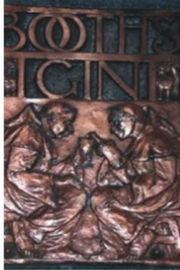 This old pub covered with green mosaics and which bears signs with brass letters is located in an unfortunate spot, squeezed between four traffic congested roads and the grim looming figure of the railway bridge. Indoors, however, the pub is splendidly enchanting, with its collage of striped marble crossed by numerous waves and veins, its golden mosaics and bronze statues.
This old pub covered with green mosaics and which bears signs with brass letters is located in an unfortunate spot, squeezed between four traffic congested roads and the grim looming figure of the railway bridge. Indoors, however, the pub is splendidly enchanting, with its collage of striped marble crossed by numerous waves and veins, its golden mosaics and bronze statues.Between 1905 and 1921, the architect Fuller-Clark, and the sculptors Henry Poole and Frederick Calicò, inspired by the friars' convent which once stood in this place, threw themselves into a frenzied decorative operation on the monastic theme. They included details in the Art Nouveau and Arts & Crafts styles, mixing them with Byzantine and Old English styles, for a complete jumble of patterns. All the surfaces are richly decorated and adorned, and the area between the arches of the railway has been used to form a cove-like zone. At lunch time, on working days, the pub is quite crowded.

The pillars of Blackfriars Railway Bridge -
The groups of red pillars standing near the Blackfriars railway bridge, are the remains of a different bridge, which stood here until 1864 and had been built by Joseph Cubitt and F.T. Turner for the railway company London. Chatham & Dover. The gigantic emblem is one of the most beautiful examples of public heraldry. Proceeding clockwise, there are the coats of arms representing Kent, Dover, Rochester and the City. The motto of the railway company comes from the invincible white horse of Kent, and the first steam engine locomotive had been baptized Invicta.
THE MERMAIDS AND MERMEN OF UNILEVER HOUSE
100 VICTORIA EMBANKMENT
UNDERGROUND: BLACKFRIARS
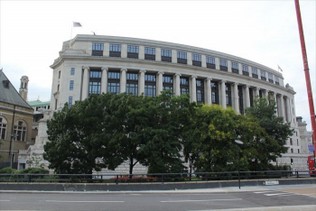 This gorgeous neoclassical building with a bent-over facade stands on the side of Victoria Embankment and bears numerous Art Déco decoration details. At the fifth floor one can observe some majestic ionic pillars and the large sculpted monogram of the Unilever company. On the imposing plinths at the angles, stand sculptures portraying a man and a woman holding back a horse. These are by Reid Dick, and go by the name of Controlled Energy. They are surrounded by other sculptures of mermaids and mermen. During the renovation of the 1970s, other parapet statues by Nicholas Monto were added. In more recent years, a lovely hanging garden has been formed on the roof.
This gorgeous neoclassical building with a bent-over facade stands on the side of Victoria Embankment and bears numerous Art Déco decoration details. At the fifth floor one can observe some majestic ionic pillars and the large sculpted monogram of the Unilever company. On the imposing plinths at the angles, stand sculptures portraying a man and a woman holding back a horse. These are by Reid Dick, and go by the name of Controlled Energy. They are surrounded by other sculptures of mermaids and mermen. During the renovation of the 1970s, other parapet statues by Nicholas Monto were added. In more recent years, a lovely hanging garden has been formed on the roof. At number 130 of the nearby Queen Victoria Street there is an impressive Seventeenth-century building which hosts the institute for heraldic studies. The College of Arms is the depository of the coats of arms and the family trees of the families of British nobility. Here one can find people specialized in genealogical research, authorized to assign the coats of arms and make decisions on the protocol. It is a corner of the past. One of the doors is open to the public and the archive can be visited by guided groups by booking.

PLAYHOUSE YARD
UNDERGROUND: BLACKFRIARS
UNDERGROUND: BLACKFRIARS
In the area which is now occupied by a field flanked by buildings, the Blackfriars theatre once stood, in the Seventeenth Century, created by Richard Burbage, maestro of the royal chapel choir and a precocious theatre actor. He had rented part of the monastery, which had been closed since 1539, and had transformed it into a theatre for the choir boys. The rehearsals for shows were open to the public, but the final representation of the comedies was destined for the royal court alone. The part of the monastery which had been turned into a theatre was beyond the jurisdiction of the City, where such types of activities were banned, in that they were considered breeding grounds for uprisings and vices. Burbage was the first actor to interpret the roles of Hamlet, Macbeth and Othello. He would use this setting for shows in the winter, whereas during summertime Shakespearian plays were held at the Globe.

In Black Friars Lane stands the pharmacists' building, Apothecaries Hall, situated on the grounds of what was once the Dominican monastery. The Society of Apothecaries, in charge of the preparation of galenic pharmaceuticals, was founded in 1617, and in 1633 its first headquarters was opened in the monastery's lodgings. Today's building stands on the three sides of a breathtaking courtyard and many modifications have been made. The wooden staircase which leads to the chambers of the first floor is simply magnificent. In the glass dressers one can admire an array of pharmaceutical vases.
CHURCH OF ST ANDREW-BY-THE-WARDROBE
QUEEN VICTORIA STREET
UNDERGROUND: ST PAUL'S, MANSION HOUSE
UNDERGROUND: ST PAUL'S, MANSION HOUSE
"St. Andrew-by-the-wardrobe" is an odd name for a church, and is due to the fact that it is near the house where Edward III had his wardrobe kept. The king had purchased the house in 1359 in order to transfer his ceremonial robes and weapons there. The building had been destroyed in the Great Fire, but the name still preserves the memory. The church was later rebuilt upon Wren's design, yet destroyed once again by the German bombing. The building we find today dates back to 1961, and stands above the road level.
Within its walls, many items from other churches are safeguarded. The most illustrious vicar of St Andrews was William Shakespeare, who worked at the nearby theatre of Blackfriars. Inside the church, there is a monument in his memory.
In the nearby Deans Court stands St Paul's Deanery, a brick building from 1670 constructed by Wren, which bears a gorgeous door. Passing under an arch, one reaches the minute Wardrobe Place, slightly hidden behind an arcade, its houses dating back to the early Eighteenth Century, and amongst them is the building which used to guard the kings wardrobe. The pedestrian crossing called Wardrobe Terrace descends towards the banks of the Thames.

THE SALVATION ARMY
101 QUEEN VICTORIA STREET
UNDERGROUND: BLACKFRIARS
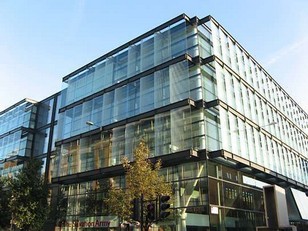 Near Blackfriars bridge, is the international headquarters of the Salvation Army, an organization founded in 1865 in the East End of London by the preacher William Booth and his wife Catherine, under the name of Christian Mission. In 1878, Booth had decided to give it an almost military structure, with himself in the role of general, and decided to call it the Salvation Army. At first, the organization encountered significant opposition because of its activities, in spite of the fact that the uniforms, ranks, and fanfare had impressed the popular imagination. Today the international headquarters of the organization continues to reside in London, however the country where it is most widespread is the USA. However, in films - for example in the musical Guys and Dolls - we only ever see its members singing Christmas Carols, shaking a tin can to collect money in front of supermarkets, volunteers assisting the homeless or unemployed, and fighting against the human trafficking and overcrowding of prisons. The most famous work which portrays them is the theatrical comedy by George Bernard Shaw, Major Barbara, where the main character, Barbara Undershaft, who ranks as an officer, is disappointed by the fact that the organization accepts money from a weapon maker and owner of distilleries, such as her father.
Near Blackfriars bridge, is the international headquarters of the Salvation Army, an organization founded in 1865 in the East End of London by the preacher William Booth and his wife Catherine, under the name of Christian Mission. In 1878, Booth had decided to give it an almost military structure, with himself in the role of general, and decided to call it the Salvation Army. At first, the organization encountered significant opposition because of its activities, in spite of the fact that the uniforms, ranks, and fanfare had impressed the popular imagination. Today the international headquarters of the organization continues to reside in London, however the country where it is most widespread is the USA. However, in films - for example in the musical Guys and Dolls - we only ever see its members singing Christmas Carols, shaking a tin can to collect money in front of supermarkets, volunteers assisting the homeless or unemployed, and fighting against the human trafficking and overcrowding of prisons. The most famous work which portrays them is the theatrical comedy by George Bernard Shaw, Major Barbara, where the main character, Barbara Undershaft, who ranks as an officer, is disappointed by the fact that the organization accepts money from a weapon maker and owner of distilleries, such as her father. FARADAY BUILDING
QUEEN VICTORIA STREET
UNDERGROUND: BLACKFRIARS
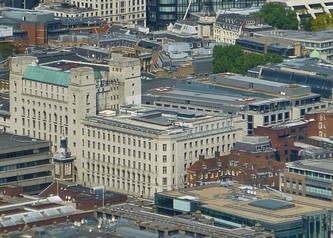 In the minds of many, the name Michael Faraday is linked to the theories of electromagnetism, electrochemistry, and to the Faraday effect, as well as electrical capacity, measured in farads. The British physicist who tied his name to all these inventions was a poor man, and because of this, in 1848 he had been assigned one of the houses as a life concession from the sovereign at Hampton Court. Today the building bears his name, as does the street it stands on. The Faraday Building complex, instead, was the central quarters for British telephone network and for international telephones, in the Thirties and Forties. The building, which covered the view of St Paul's Cathedral from the river, caused such a great number of protests that it led to a law which prohibits the construction of such tall buildings.
In the minds of many, the name Michael Faraday is linked to the theories of electromagnetism, electrochemistry, and to the Faraday effect, as well as electrical capacity, measured in farads. The British physicist who tied his name to all these inventions was a poor man, and because of this, in 1848 he had been assigned one of the houses as a life concession from the sovereign at Hampton Court. Today the building bears his name, as does the street it stands on. The Faraday Building complex, instead, was the central quarters for British telephone network and for international telephones, in the Thirties and Forties. The building, which covered the view of St Paul's Cathedral from the river, caused such a great number of protests that it led to a law which prohibits the construction of such tall buildings. One statue of Faraday, with a vast cape which hangs down to his feet, is found in Savoy Place. Between 1991 and 2001 the twenty pound note bore his portrait.
PAINTERS AND WINE MAKERS
9, LITTLE TRINITY LANE
UNDERGROUND: MANSION HOUSE
The elegant Painters' Hall, rebuilt in 1961, is also the headquarters of the Worshipful Company of Painter-Stainers, which was already notorious in 1268. In 1800 many artists and scholars, such as Reynolds and Leighton, became Livery-men, in other words members of the corporation. Courses of decorative arts and crafts and many exhibitions were held there. In 2000 the Millennium Salon took place there, and on show were the works of artists from all over the world. On the red walls of its chambers a great deal of beautiful portraits and paintings can be admired.

At number 68 of the nearby Upper Thames Street stands the winemakers building, known as Vintners' Hall. Near Southwark bridge there used to be an arrival dock for French wine, which was called Garlick-hythe, because, as well as wine, also garlic would arrive from France. The company motto was “Vinum Exhilarat Animum ', meaning "wine uplifts the spirit”. The splendid Court Room is dressed in panels with ribbed and elaborate pillars and the balustrade of the charming wooden staircase is decorated with wreaths of flowers and baskets of fruit. There is also a delightful collection of wine glasses and silver chalices.
The nearby church of St James Garlickhythe, on Garlick Hill, which has been around since the Eleventh Century, has a gate in the shape of vine shoots. In the bell tower there is a mummified body of a man which may be up to three centuries old and perhaps once went by the name of Jimmy Garlick. It was discovered by some workers on the job, and later placed inside a tomb within the bell tower, dressed in a white shirt.
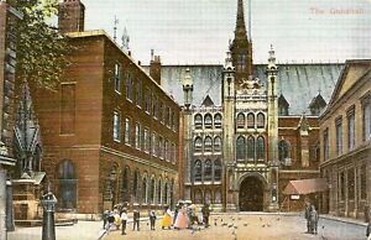 The Guildhall is a building that has been used for centuries as headquarters for the town hall and is still today used as the administrative centre of the city; it is where the Lord Mayor is elected.
The Guildhall is a building that has been used for centuries as headquarters for the town hall and is still today used as the administrative centre of the city; it is where the Lord Mayor is elected. The most ancient part of it dates back to 1411 and was built above two crypts, then there is a medieval part, which is one of the few examples of the epoch still remaining in the city.
The Great Fire of 1666 damaged much of the building, which was then restored by Wren. In 1788 George Dance remade the facade, endowing it with new windows and many pinnacles. The building we see today, however, is largely the result of the post-war restructuring, assigned to Giles Gilbert Scott. There are various statues, amongst which those of Gog and Magog, sculpted in wood. The library, opened in 1873, not only contains books, but also a large collection of manuscripts, maps, printed material, portraits, photographs, and drawings of London, its history, and its inhabitants. Right behind Guildhall, in Oat Lane, are the buildings of the Worshipful Company of Pewterers and Milliners. The southern extremity of the building overlooks Gresham Street, where at number 25, there is a small artificial garden, on the area of the old cemetery of St John Zachary's Church, destroyed by the Great Fire. Next to it, is a bizarre modern building, its shape curving inward at the upper floors. In nearby Noble Street, one can still see the foundations of a piece of a wall built by the ancient Romans.
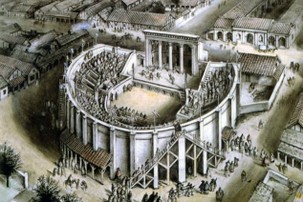
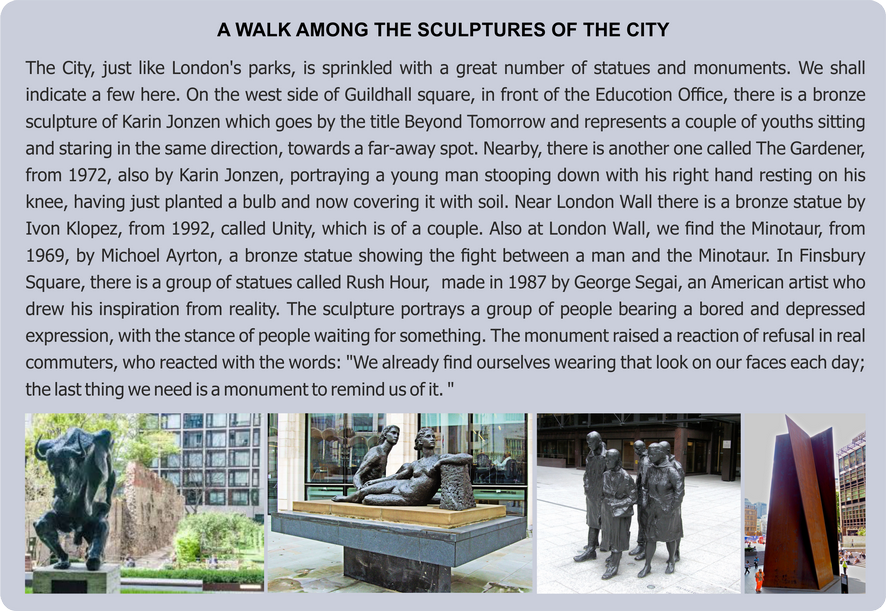
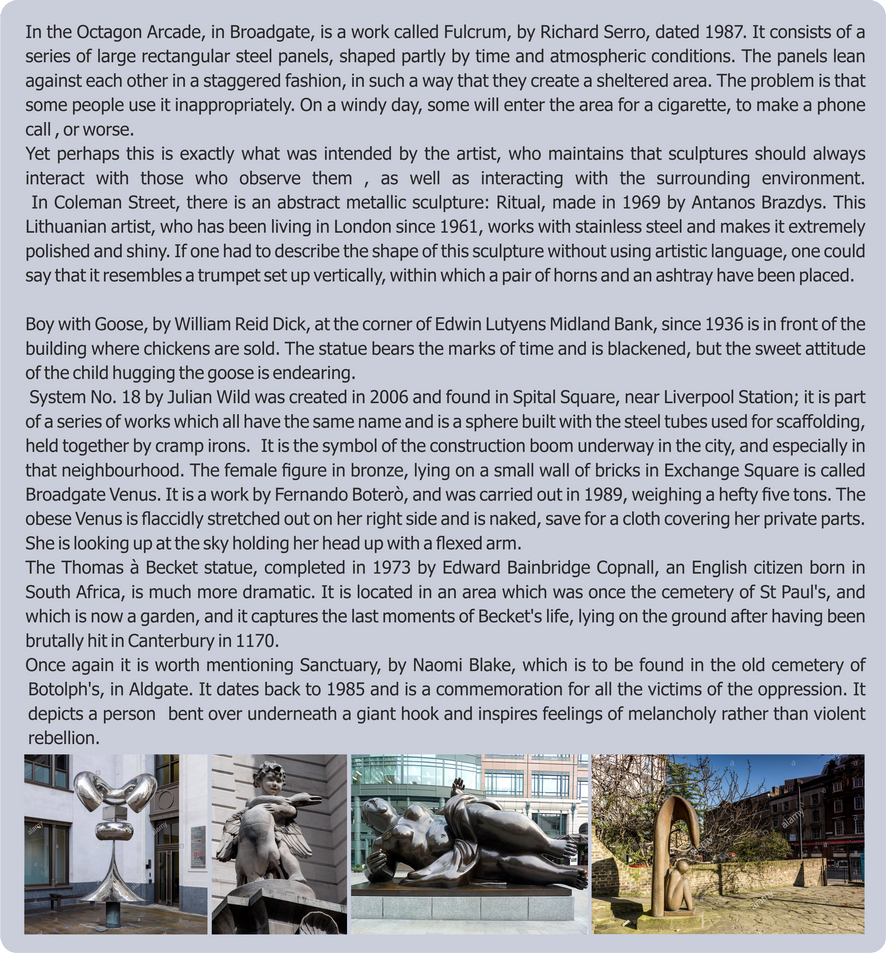
GUILDHALL ART GALLERY
GUILDHALL YARD
UNDERGROUND: ST PAUL'S
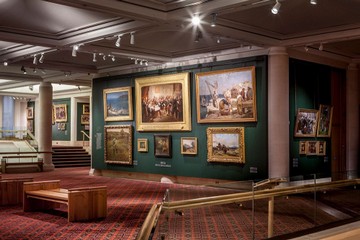
The original gallery was opened in 1885 for the exhibition of the works of art possessed by the corporation. Unfortunately, it was destroyed by bombardments in 1941and the building we see today dates back to 1999. The collection of paintings includes some views of London and scenes of life in the capital, ranging from 1500 to today. The paintings owned are about four thousand and are exhibited following a rotation plan, so as to exhibit around four hundred canvases at a time. Amongst the many subjects, there are portraits of royal characters, the Great Fire of 1666, and some scenes of navy battles in the Victorian period. There are also some paintings by Leighton, Constable, and some by Pre-Raphaelites, amongst which La Ghirlandata by Dante Gabriel Rossetti.
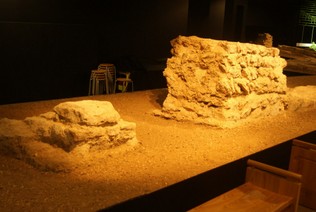 Roman amphitheatre - In 1988, a vast archaeological zone was discovered by chance in the Bank area. In the underground part of the gallery, near Gresham Street in particular, are some remains that date back to a period somewhere between the 1st and 2nd century and which include an amphitheatre and an oval arena, which measure one hundred metres by eighty, and whose staircases could once contain six thousand spectators. The size of the amphitheatre is indicated by the circle of black rocks set into what forms the pavement of the vast courtyard opposite the gallery. Also some ruins of the eastern wall remain, as well as a splendid mosaic floor. The missing parts (the building had been abandoned for centuries and a brick door had been used for other constructions) have been fulfilled evocatively with the help of digital technology, which gives us an idea of what the original must have been like, and draws us a little closer to the gladiators.
Roman amphitheatre - In 1988, a vast archaeological zone was discovered by chance in the Bank area. In the underground part of the gallery, near Gresham Street in particular, are some remains that date back to a period somewhere between the 1st and 2nd century and which include an amphitheatre and an oval arena, which measure one hundred metres by eighty, and whose staircases could once contain six thousand spectators. The size of the amphitheatre is indicated by the circle of black rocks set into what forms the pavement of the vast courtyard opposite the gallery. Also some ruins of the eastern wall remain, as well as a splendid mosaic floor. The missing parts (the building had been abandoned for centuries and a brick door had been used for other constructions) have been fulfilled evocatively with the help of digital technology, which gives us an idea of what the original must have been like, and draws us a little closer to the gladiators. 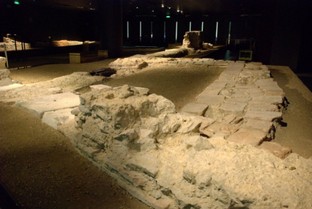 The relics in the display cabinets include many objects of everyday use, such as iron tools used for engraving and cutting tablets of wax. There are also some hair clips, clay vases, a horseshoe, and some leather sandals. This is a visit not to be missed if one wishes to get an idea of Roman London.
The relics in the display cabinets include many objects of everyday use, such as iron tools used for engraving and cutting tablets of wax. There are also some hair clips, clay vases, a horseshoe, and some leather sandals. This is a visit not to be missed if one wishes to get an idea of Roman London. CLOCKMAKERS MUSEUM
GUILDHALL LIBRARY ALDERMANBURY
UNDERGROUND: ST PAUL'S
The Clockmakers Museum is in a room of the guild library and safeguards ancient manuscripts and books which date back to 1813 onwards. 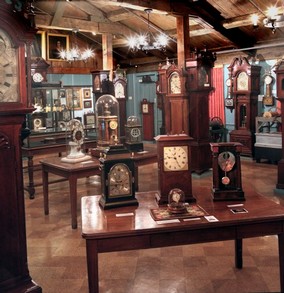 The clock collection began in 1814 and is the oldest in the world. It is formed by roughly seven hundred specimens gathered through the years by the Worshipful Company of Clockmakers. There are pocket watches, wrist watches, wall clocks, sandglasses, and sundials... Another interesting item is a gas clock and some old electric pendulums. Amongst the marine chronometers is that once owned by John Harrison, from 1772, which solved the problem of measuring longitude at sea. They all represent the result of the research of many years and acquisitions made by the company, which also managed to obtain that worn by Edmund Hillary whilst climbing Mount Everest. The clocks and watches have been placed within modern display cabinets which are intensely illuminated and tell the story of clock-making in London. If one visits at midday, one can hear them chime all together.
The clock collection began in 1814 and is the oldest in the world. It is formed by roughly seven hundred specimens gathered through the years by the Worshipful Company of Clockmakers. There are pocket watches, wrist watches, wall clocks, sandglasses, and sundials... Another interesting item is a gas clock and some old electric pendulums. Amongst the marine chronometers is that once owned by John Harrison, from 1772, which solved the problem of measuring longitude at sea. They all represent the result of the research of many years and acquisitions made by the company, which also managed to obtain that worn by Edmund Hillary whilst climbing Mount Everest. The clocks and watches have been placed within modern display cabinets which are intensely illuminated and tell the story of clock-making in London. If one visits at midday, one can hear them chime all together.
 The clock collection began in 1814 and is the oldest in the world. It is formed by roughly seven hundred specimens gathered through the years by the Worshipful Company of Clockmakers. There are pocket watches, wrist watches, wall clocks, sandglasses, and sundials... Another interesting item is a gas clock and some old electric pendulums. Amongst the marine chronometers is that once owned by John Harrison, from 1772, which solved the problem of measuring longitude at sea. They all represent the result of the research of many years and acquisitions made by the company, which also managed to obtain that worn by Edmund Hillary whilst climbing Mount Everest. The clocks and watches have been placed within modern display cabinets which are intensely illuminated and tell the story of clock-making in London. If one visits at midday, one can hear them chime all together.
The clock collection began in 1814 and is the oldest in the world. It is formed by roughly seven hundred specimens gathered through the years by the Worshipful Company of Clockmakers. There are pocket watches, wrist watches, wall clocks, sandglasses, and sundials... Another interesting item is a gas clock and some old electric pendulums. Amongst the marine chronometers is that once owned by John Harrison, from 1772, which solved the problem of measuring longitude at sea. They all represent the result of the research of many years and acquisitions made by the company, which also managed to obtain that worn by Edmund Hillary whilst climbing Mount Everest. The clocks and watches have been placed within modern display cabinets which are intensely illuminated and tell the story of clock-making in London. If one visits at midday, one can hear them chime all together.